Montecito’s 2022 Year in Review

Project Progress
Highway 101 Widening Project
The long-awaited widening project from Carpinteria to Santa Barbara was discussed at length in 2022, with countless meetings to discuss design, construction, timing, and other details related to the addition of a third lane through Montecito.
The Montecito segment of the project (called 4D) includes widening 1.4 miles of both directions of the freeway, from just before the Romero Creek bridge to Olive Mill Road. The project will add a third, part-time High Occupancy Vehicle (HOV) lane that will be in effect on weekdays from 6 am to 9 am, and 3 pm to 6 pm, and includes replacing the existing roadway pavement with 40-year concrete pavement; removal of 158 oak trees (to be replaced at a 3:1 or 2:1 ratio) and 20 other native trees (to be replaced at a 1:1 ratio); installation of median barriers, guardrails, fencing, retaining walls, and new landscaping; reconstruction of the freeway bridges over Cabrillo Boulevard plus a new southbound on-ramp; and replacement of the bridges over Romero Creek, San Ysidro Creek, and Oak Creek. The widening project is being designed with the most recent standards and safety upgrades, according to the planners.
In February, it was announced that the four proposed sound walls – three on the north side of the freeway between Olive Mill and the Romero Creek bridge, and one on the south side between Olive Mill and San Ysidro roads – had been removed from the project after County Flood Control required project reps to analyze if the sound walls would create a rise in flood waters, based on Recovery Mapping that was adopted in 2018 in response to the 1/9 Debris Flow; the analysis showed that a rise in flood waters would occur due to the sound walls.
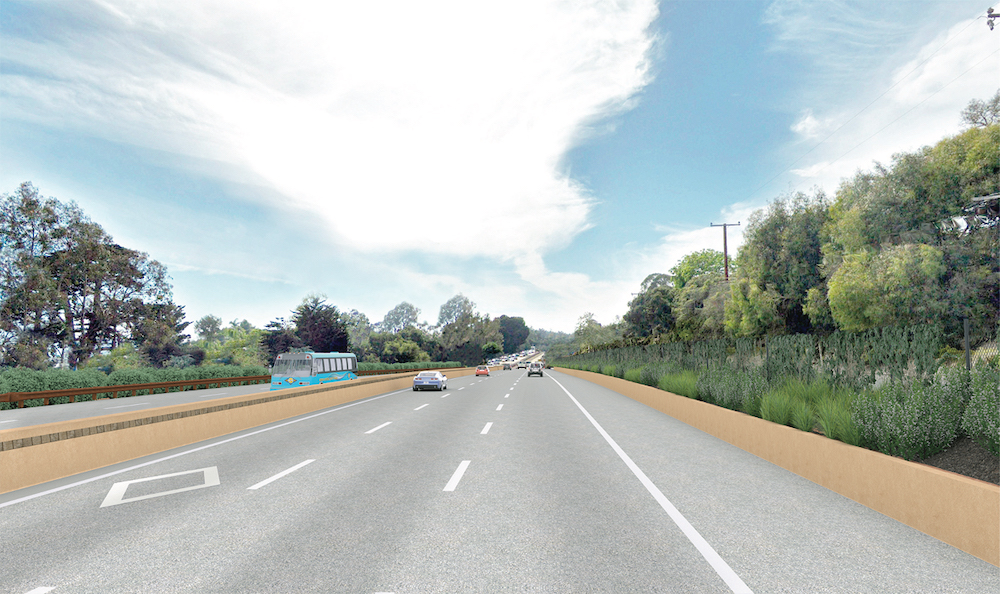
According to Kirsten Ayars, the team also studied alternate wall types and configurations, such as walls with flood gates, staggered walls with openings, shorter walls, and other alternatives that might alleviate the potential of flooding. Unfortunately, the options also resulted in a rise in flood waters during hydraulic modeling, did not meet freeway safety requirements, and/or would not meet the federal sound wall requirements. The sound walls were not required as a sound mitigation measure as part of the project’s Environmental Impact Report. Noise in the area is expected to increase up to three decibels, with an average dishwasher creating 80 decibels.
In place of the sound walls, black coated chain link fencing planted with vines and landscaping is proposed. According to project reps, the freeway widening will cause a less than five decibel increase in sound for the majority of the community, thanks in part to the use of reinforced concrete pavement, which is the quietest roadway surface that has been developed to date. The surface has a long lifespan and reduces tire noise because cars are not going over degraded areas.
The project was in front of Montecito Board of Architectural Review in February for the second time, where the Board reviewed aesthetic features of the project related to fencing, landscaping, and lighting. MBAR comments about the fences and landscaping were mostly positive, save for one slide showing a vantage from the frontage road, North Jameson, northbound to Olive Mill, in which there is no room for plantings on either side of the freeway fencing. MBAR members asked project reps to revisit the area and come up with a plan that addresses the lack of landscaping.
The Board also considered the project in March, reviewing corridor-wide elements including median barriers, guardrails, contrast surface treatments, and overhead signage.
The Montecito Planning Commission had its first opportunity to look at the freeway widening project in May. SBCAG’s Fred Luna said the planning for the freeway widening began many years ago, with increased traffic causing 7.5 hours of delay in 2022, expected to increase to 11 hours per day in 2040. This is in addition to increased air pollution, increased traffic diverting off freeway onto local roads, and a decreased quality of life for communities between major commuter areas including Santa Barbara, Goleta, and Ventura. The project is being funded through federal, state, and local funds, including a significant portion through Measure A funds.
At that meeting, Ayars said that the aesthetics of the much-discussed project were designed with a semi-rural feel, using drought-tolerant landscaping and visual improvements, and that the project has undergone an extensive community process. Intents of the project include freeing up local lanes for local traffic, updating 1950s-era connections between Montecito and 101, and staying within existing right-of-ways. Two parallel projects in the segment – a roundabout at Olive Mill Road and Coast Village Road, and a roundabout at San Ysidro and North Jameson – aim to enhance local roads, helping pedestrian, bike, and vehicle access.
Most areas of the freeway project include widening into the median instead of the outside lanes, which makes building in the existing right-of-way possible, rather than condemning nearby properties to accommodate the increased footprint of the freeway. Much of the current existing median plantings are to be removed to accommodate the new lane, with shrubbery, vines, and trees focused on the perimeter of the freeway for screening purposes.
At the MPC hearing, discussion ensued related to the flooding data utilized to justify the removal of the sound walls, with several commissioners saying there is a larger issue at play: the insufficient size of the culverts under the freeway. Increasing the size of those culverts is not currently part of the freeway widening project, but is expected to be addressed with a project well into the future, according to Flood Control reps.
Commissioners asked Planning & Development Director Lisa Plowman to organize another meeting to conceptually consider the project, asking for additional studies related to the flood data. Commissioner Marshall Miller also asked about the possibility of adding sound walls down the road, once the culvert expansion project is complete. The meeting was continued in a special hearing in June.
In June, Commissioners asked difficult and complicated questions to reps of the Highway 101 widening project. The second hearing in a series of three conceptual reviews at MPC, the meeting was to hear Commissioner comments and concerns in preparation for a Santa Barbara County Planning Commission hearing in the fall. MPC is in an advisory role for this project, as the SBPC is the decision maker; appeals will go to the Santa Barbara County Board of Supervisors.
Planning Commissioners took issue with the fact that the analysis that ruled out the sound walls was gleaned from multiple data sources, some of which they felt was outdated as they did not take into effect new resiliency measures including larger (or new) debris basins, creek nets, and enhanced bridges. Commissioners asked project reps to come back with consolidated information related to the analysis of the flood risk, as well as a better explanation of terms related to the project.
In a six-hour meeting in August, the Commission completed their review of the project, sending their recommendations and comments to the Santa Barbara County Planning Commission (SBPC). As in previous hearings, Commissioners continued to take great issue with the removal of sound walls from the project. Project reps reported that Caltrans has committed to completing a broader watershed analysis in Montecito to identify issues both inside and outside their State right-of-way. “They’re taking a larger picture into consideration,” said Ayars.
Commissioners also considered the timing of two parallel projects as part of the highway construction: the Olive Mill roundabout and the San Ysidro roundabout. Commissioners asked the team to try and avoid repeat on- and off-ramp closures, and to stagger the roundabout and freeway construction in the most efficient way possible.
After lengthy deliberations and after questioning why the MPC was not the final decision-making body for the project instead of the County Planning Commission, Commissioners formulated a handful of recommendations to be sent to the Planning Commission. They stated that if the new watershed study that is being undertaken allows for sound walls, Caltrans shall construct sound walls that will accommodate the passage of water, and that Caltrans shall include the sound walls in their funding request. They also stated that the project shall be designed and constructed such that future sound walls can be accommodated (i.e. the footings for sound walls shall be installed). Also related to the sound walls, the Commission asked that if sound walls are not constructed as part of the project, the four-foot wall extending from a retaining wall in front of the Miramar Resort on the south side of the freeway shall be modified or removed to avoid sound reflectivity.
Other recommendations included asking that the Olive Mill roundabout be operational prior to the construction on the freeway; tree removal be minimized and on-site replanting be prioritized; and reclaimed water be used for dust mitigation for highway construction and landscaping be irrigated with recycled water, where feasible. An additional comment was also added, asking that the freeway bridges be constructed to accommodate a 100-year storm event to ensure that the proposed bridges will not be a limiting factor that prevents sound walls from being built in the future.
In December, the Santa Barbara County Planning Commission unanimously approved the project segment through Montecito, with a condition that Caltrans potentially revisit the idea of sound walls when new flood mapping is released. Other conditions include putting a plan into place to mitigate construction sound, among other items.
Construction on the freeway project is expected to begin in Summer 2023, and will take 2.5 years to complete. For more information, visit www.sbroads.com.
The Biltmore & Coral Casino
A class-action lawsuit was filed in late January by former employees at the Four Seasons Resort The Biltmore against Montecito resident Ty Warner and his hotel company.
The lawsuit noted that at the beginning of the pandemic in March 2020, 450 employees of the resort were furloughed, with hotel operators not being forthcoming about when or if the hotel would reopen. The lawsuit alleges that by keeping the hotel closed, employees were in a state of limbo where they had no rights as they were on “temporary furlough” but not terminated. If they were to have resigned, they would lose their entitled separation pay, among other benefits. The lawsuit adds that plaintiffs and class members have suffered and continue to suffer substantial losses in earnings and job benefits, and have suffered extreme and severe mental anguish, emotional distress, and pain and suffering. The lawsuit sought $6,000,000 in damages. The suit was handled by law firm Anticouni & Ricotta of Santa Barbara.
In June, Warner gave members an update for his plans on reopening the nearby exclusive beachside club, Coral Casino, which has been closed since the onset of the COVID-19 pandemic. It is anticipated that the club will reopen in the first quarter of 2023, after improvements and renovations of existing facilities and the club’s offerings.
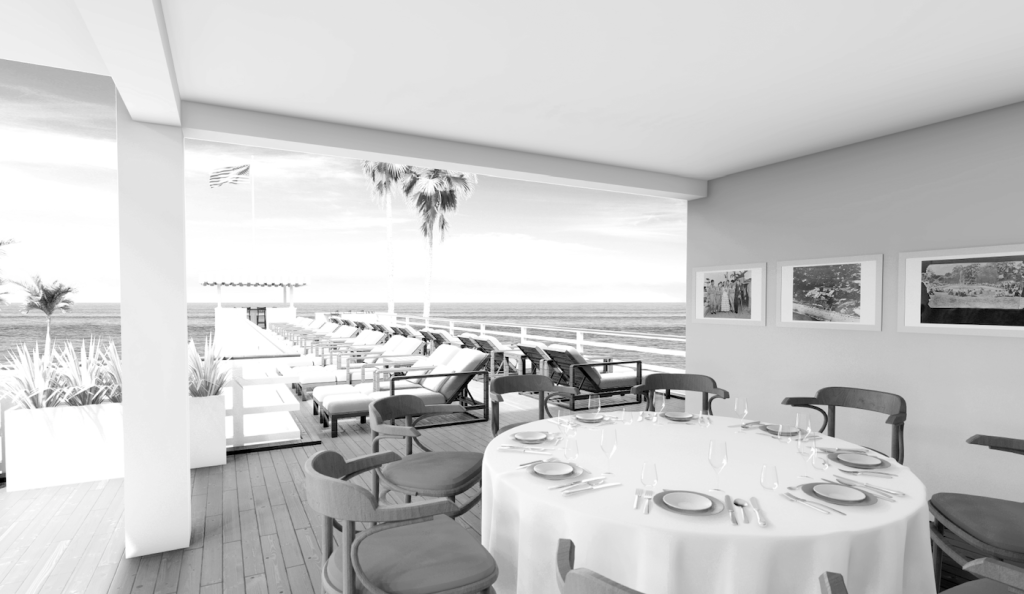
A spokesperson for Ty Warner Hotels & Resorts Bill Medel and Membership Directors Kelly Campbell and Johanna Dearinger told us that upon opening, the Coral Casino – which as of March 2022 is under Ty Warner’s management instead of the Four Seasons – will be exploring new policies and procedures to create a better balance of use of the iconic club. This includes finding ways to offer more of a members-only experience with club facilities including the pool, fitness, locker rooms, and spa areas.
While the team seeks to retain the exclusivity of the Club, Tydes, the iconic property’s oceanfront restaurant, may be made available to the public. There will be members-only dining areas including the new member rooftop lounge, and there will be implementation of a members-priority reservation system. The Coral Casino ballroom will continue to be an event venue for the community and public.
The Club has been undergoing substantial amenity upgrades and renovations during the closure; it’s been about 15 years since it underwent its last round of renovations. New amenities for members will include a new rooftop lounge with lounge furniture, a fire pit, and direct views of Butterfly Beach and sunsets, located in the area immediately adjacent to Tydes’ dining room on the west end of the property; upgrades to the private dining room, which will be opened to the second deck and boast new retractable doors and windows; new lighting, heating, and seating to the Crow’s Nest plus a glass windscreen; expansion of Fins, the juice and breakfast bar; enlargement and relocation of the Children’s Pool to the former whirlpool spa site next to the diving board; expansion and relocation of the whirlpool spa to the edge of the pool deck; expansion of the pool deck by the clock tower, offering a more private setting with unobstructed panoramic ocean views; and a new cold plunge pool adjacent to the whirlpool spa, offering members the benefits of cold-water immersion. The renovation project, which requires a substantial conformity permit, was seen by the Historic Landmarks Advisory Commission in fall of 2020; commissioners approved the proposed changes to the historic landmark in a 5-1 vote.
In November, we reported exclusively on the continued legal battle between Warner and hotel management company Four Seasons, with Warner filing a petition at the United States District Court, Southern District of New York, asking that the Courts step in to appoint arbitrators to hear the dispute between the two sides.
Mr. Warner served notice to the Four Seasons in March 2021 terminating their long-term agreements at both the Four Seasons Santa Barbara and Four Seasons New York after accusing the Four Seasons of mismanagement of the hotel properties; he says the Four Seasons was in violation of its contractual and fiduciary duties, to the financial detriment of Mr. Warner. The filing stated that the owner has invested hundreds of millions of dollars into the hotels to fund extensive renovations and perform ongoing maintenance, and to support day-to-day operations, and that the Four Seasons did not uphold its duties to maximize profits and minimize costs while operating the properties consistent with the standard of world-class luxury hotels. The Four Seasons contested the termination of the agreements and has refused to vacate the properties.
An arbitration agreement between Mr. Warner and the Four Seasons provided that their dispute shall be resolved by a panel of three arbitrators. For more than five months, both sides attempted to constitute the panel of arbitrators, and they had collectively exchanged eight lists of potential arbitrators and considered 65 different candidates. The parties did not reach an agreement on even one arbitrator, let alone the three that were necessary to form the panel. “The parties are trapped in a selection process that has proven fundamentally unworkable and lacks any mechanism for breaking the existing deadlock,” reads the Court filing. “Without a panel in place, the parties cannot proceed with their arbitration and [Mr. Warner] cannot have [his] claims against Four Seasons heard and resolved on the merits.”
The Four Seasons Resort The Biltmore was shuttered at the beginning of the COVID-19 pandemic, and has yet to reopen in over two and a half years. Warner maintains that he has no plans to sell any of his Montecito properties, which include the Biltmore, the Coral Casino, Montecito Club, and the San Ysidro Ranch. He told the Journal last year that he is using the property closure as an opportunity to reinvest in the beloved resort.
The petition was filed on October 31, 2022.
Casa Dorinda
In March, we reported on the Bliss Expansion at Casa Dorinda, an ambitious renovation that added new luxury living space, more options for dining and entertainment, and state-of-the-art medical care on the Casa Dorinda estate.
The Casa Dorinda team, including Executive Director Brian McCague, made a tremendous effort to minimize the effect of construction on residents’ daily life. This meant limiting construction crew hours, as well as keeping noise pollution to a minimum. It was a process that required both patience and first-rate organization.
While Casa Dorinda has been celebrated for its elegant dining room, the Bliss Expansion expanded its services with The Grill – a fun, new dining space that offers residents a more casual option. With a full bar and extended hours, The Grill was designed to be a place where residents could dress up as much or as little as they wanted, spending the afternoon watching the game while enjoying some snacks. As such, The Grill has quickly become a favorite among residents, who enjoy the big city feel of the open kitchen design and the warm atmosphere.
Also happening at Casa Dorinda: in December we reported on upcoming plans to beautify the “triangle” in front of Casa Dorinda, where Olive Mill and Hot Springs roads meet.
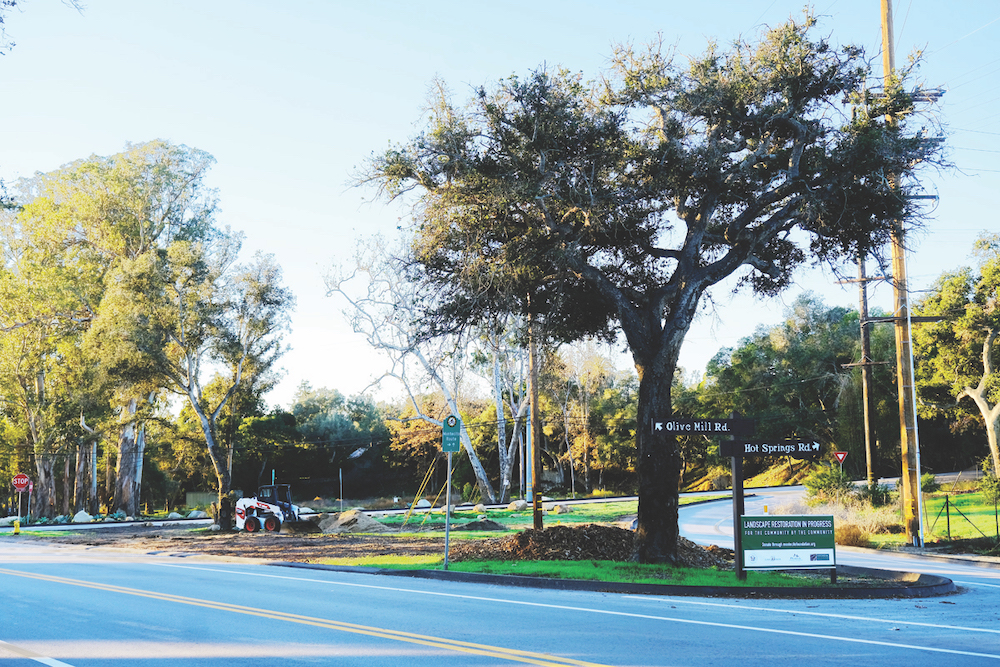

The $200,000 project is being funded in part by Montecito Community Foundation, with help from Casa Dorinda and the Garden Club of Santa Barbara. MCF is currently seeking donations to help meet the goal.
The area was badly damaged during the debris flow nearly five years ago, but County resources went to fixing roads and bridges. McCague added that the majority of the property is in public right-of-way save for a small corner, and that the triangle has historically been irrigated by water from Casa Dorinda. “We are happy to continue voluntarily maintaining it, and the irrigation line is still intact,” he told the Montecito Association Land Use Committee in December.
The County has signed off on the project and has issued a building permit. Designed by Arcadia Studio, the landscape is designed to embrace the Montecito landscape, including native and Mediterranean-style plantings, all drought tolerant. A rock buffer will be along the perimeter, to deter pedestrians and dog walkers. There will be a mix of ground cover and low-lying species as not to obstruct the views of drivers.
“When you drive by that area, all you think about is the debris flow,” said committee chair, Chad Chase. “This is going to make it so much better.” Montecito Water District public information officer Laura Camp also chimed in on the plans, thanking Arcadia Studio for creating a landscape plan that will be an example of water efficiency. “It’s wonderful to have an exemplary garden where everyone can see it, and that it doesn’t need a lot of water,” she said.
The project will be built once funding is complete. To help, visit www.montecitofoundation.org.
Walk Montecito
One of Montecito’s most ambitious projects continued to take shape in 2022; Walk Montecito is a project that will ultimately create eight miles of roadside walking trails throughout Montecito.
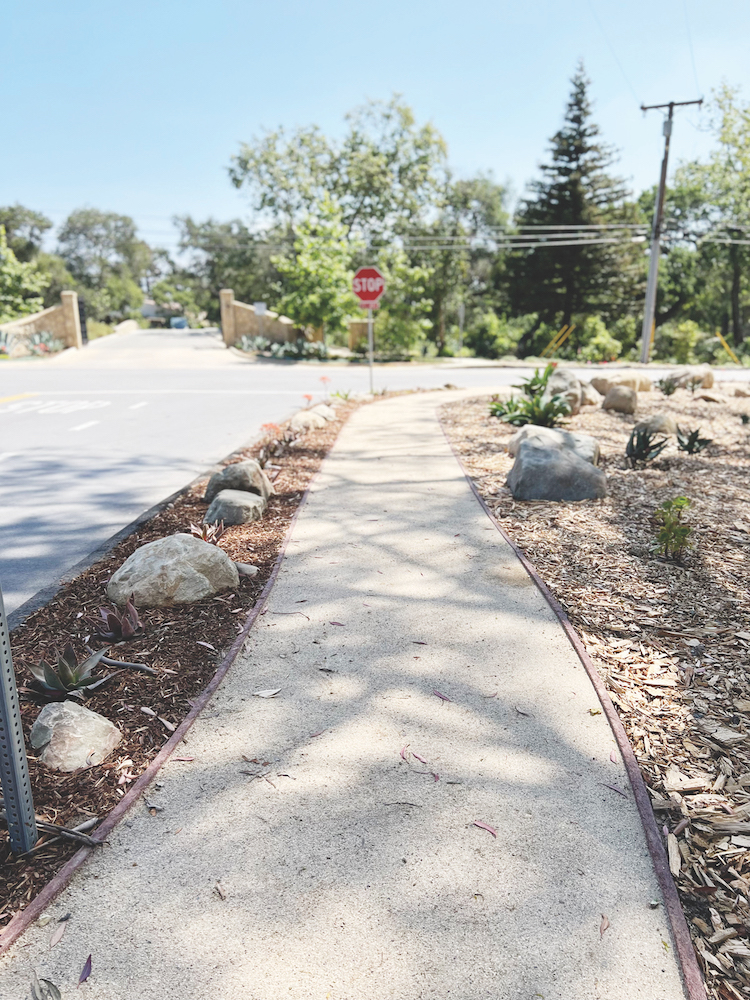
In April we met with Abe Powell, Founder of the Santa Barbara Bucket Brigade, which is spearheading the project. At that time Powell and his team – with the blessing of Santa Barbara County Public Works – had already built two miles of walking trails in the public right-of-way along North Jameson Lane, Olive Mill, and Hot Springs roads thus far, and were seeking to raise a total of $2.54M for trail construction and ongoing trail maintenance to build the remaining six miles.
The grassroots initiative calls for pedestrian improvements that are in alignment with the semi-rural ambiance of Montecito, prohibiting paved, concrete sidewalks that are incompatible with the Montecito Community Plan. The mix of formal and non-formal trails are and will be ADA friendly in most areas, and are or will be made from both decomposed granite in main thoroughfares, and informal compacted shale alongside roads, connecting to nature trails through public open spaces and parks.
With a goal of building six more miles of trail in the next three years, Powell has built an active executive committee for this campaign, co-chaired by Michael Smith and Geoffrey Slaff. The first phase of the project was the area between Casa Dorinda and Middle Road on Hot Springs Road; the corner at Olive Mill and Hot Springs roads was completed in March, with a previous section from Montecito Country Mart to Middle Road completed in 2021. Future streets earmarked for trails include Barker Pass, Camino Viejo, Eucalyptus Hill, San Leandro (Ennisbrook to Santa Rosa), Santa Rosa, Sinaloa, South Jameson, and Sycamore Canyon Road. To build the trails in most areas, the vehicle and bike lanes will be reduced in size yet still to regulation, and a new curb will be built out to accommodate the walking path. In other areas where space is prohibitive, there will not be curbs.
“Community-funded trails are the most cost-effective solution to make a community walkable,” Powell said, explaining that the path built on San Ysidro Road by Public Works took over four years to build, and cost $500,000. “Building informal trails like these aligns specifically with the Montecito Community Plan and the trail construction guidelines that were established by the Montecito Association and Santa Barbara County, and it’s a whole lot less expensive,” he said.
For more information, visit sbbucketbrigade.org.
Hot Springs Trail
A hot topic we covered thoroughly this year was the trouble at the Hot Springs Trailhead.
Back in April, we reported on the ongoing issues in the area, which ended up in litigation between four neighbors and the County of Santa Barbara. In May, Judge Donna Geck with the Santa Barbara Superior Court issued a temporary injunction against the County, preventing them from moving forward with a plan to add up to 62 parking spots in the public right-of-way near the trailhead, citing the need for more environmental review of the potential project. The hot springs – now filled with water after a lawsuit was settled between Montecito Creek Water Company and the Department of Fish and Wildlife in 2019 – became increasingly popular during the pandemic, fueled in part by increased exposure on several social media sites. The lawsuit contended that the right-of-way improvements and the addition of more parking would lead to both an increase in fire ignition risk and would affect the ability of the public to safely evacuate during a wind-driven wildfire, and that the County’s actions violate CEQA.
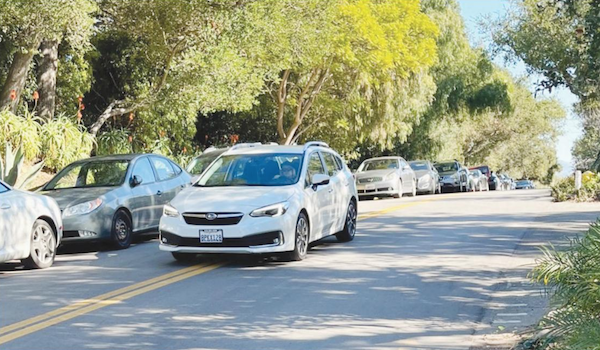
There are roughly eight to 10 parking spaces at the trailhead, and in pre-pandemic times, it would not be unusual to see 10 to 12 additional cars parked illegally along Riven Rock Road; the problem increased exponentially over the last two years. Riven Rock Road was white striped on either side of the road in April 2021, in an effort to thwart parking and maintain resident emergency evacuation routes. Many neighbors report that hikers are still parking in the area, some near the creek bank, despite hundreds of tickets being issued and cars being towed. The County struggled to hire a ranger for the area for some time, and at one point hired a security guard to enforce the dawn to dusk trail access rules.
In order to gain more parking, the County began to notify homeowners in the area to remove anything that may be impeding parking in the right-of-way, such as boulders, landscaping, and even homemade “No Parking” signs. Homeowners contended that the hundreds of cars that frequent the area on any given day are blocking driveways, blocking emergency vehicle access, and are being parked in such a way that causes safety issues for pedestrians and other vehicles. Judge Geck’s injunction, siding with plaintiffs Christopher Anderson, Ross Bagdasarian, Peter Barker, and James Morley, represented by Attorney David Cousineau of Cappello & Noel, prevented the County from issuing such notices to residents.
But in July, nearly a dozen homes on East Mountain Drive were given notice by the County of Santa Barbara to remove encroachments in the public right-of-way within a 10-day period, refueling the battle between homeowners, the County of Santa Barbara Public Works Department, and users of the Hot Springs Trail. A few days later, Santa Barbara Superior Court Judge Thomas Anderle ruled that the County violated the preliminary injunction by placing the notices, and ordered the County to immediately notify homeowners of the withdrawal of the letters.
County reps told us at the time that the new letters were in response to the pending litigation. Public Works Director Scott McGolpin, who signed each of the dozen letters, said the County must assert all claims it has related to its right-of-way in that area or risk forfeiting certain rights. “To that end, the County provided notice of the unpermitted encroachments and a 10-day opportunity to cure the properties for which it had received complaints and that had unpermitted encroachments,” he said in a statement to the MJ. “Prior to the litigation, the County received multiple complaints regarding obstructions in the public right-of-way on East Mountain Drive,” he added. The County has said the project to increase parking in the area is a “right-of-way restoration project,” which involves limited removal of road encroachments and minor road grading for the purpose of improving sight distance and to allow parking in the public space adjacent to the trailhead.
Later in July, 15 community and government reps met behind closed doors to discuss the issues at the trailhead. Although members of the media and public were not privy to the meeting, we’re told that the conversation centered on best use and management practices at the trailhead, and how best to communicate with locals and tourists about the best times to visit the trail, good practices, the history of the hot springs, and more. It was noted that many users of the hot springs and trail are local people and families, who do not leave trash, do not start fires, and park respectfully, according to frequent trail users. There are out-of-town users as well, and the group is determining how best to foster a “leave no trace” mentality for all who visit.
The takeaway from the meeting was that more data is necessary to move forward with any parking project, as well as to determine the best way to move forward with signage for the public.
Roundabouts
We published countless articles about two roundabouts coming to Montecito in the next year: one at Coast Village Road and Olive Mill Road, and one at San Ysidro Road and North Jameson.
After prepping the community that construction was on the horizon for months, community leaders and elected officials celebrated the kick-off for the Olive Mill Roundabout project on November 4. Final design approval was granted by the Montecito Board of Architectural Review and City of Santa Barbara Architectural Review Board in early November, and construction began in late November and will continue through Summer 2023.
The project, one of three parallel projects on local roads related to the 101 widening, consists of reconfiguring the current, clunky, six-legged intersection at Olive Mill Road, Coast Village Road, North Jameson Lane, Highway 101 northbound offramp, and Highway 101 southbound onramp to a single-lane roundabout. The project will include pedestrian refuge islands, sidewalks, street lighting, signage, crosswalks, landscaping, and drainage facilities. All improvements will be accommodated within existing Caltrans, City, and County right-of-way. The roundabout features improvements for motorists with a single-lane traffic circle designed to be utilized at 20 mph. Bicyclists will be able to either take the lane or dismount and use the crosswalks on the mountain side.
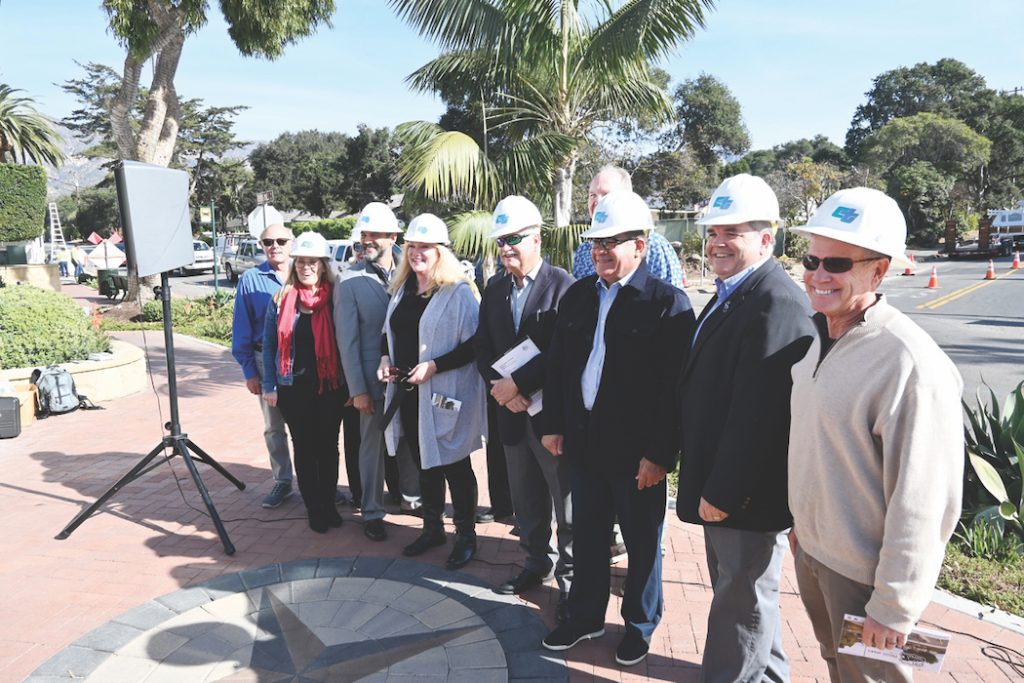
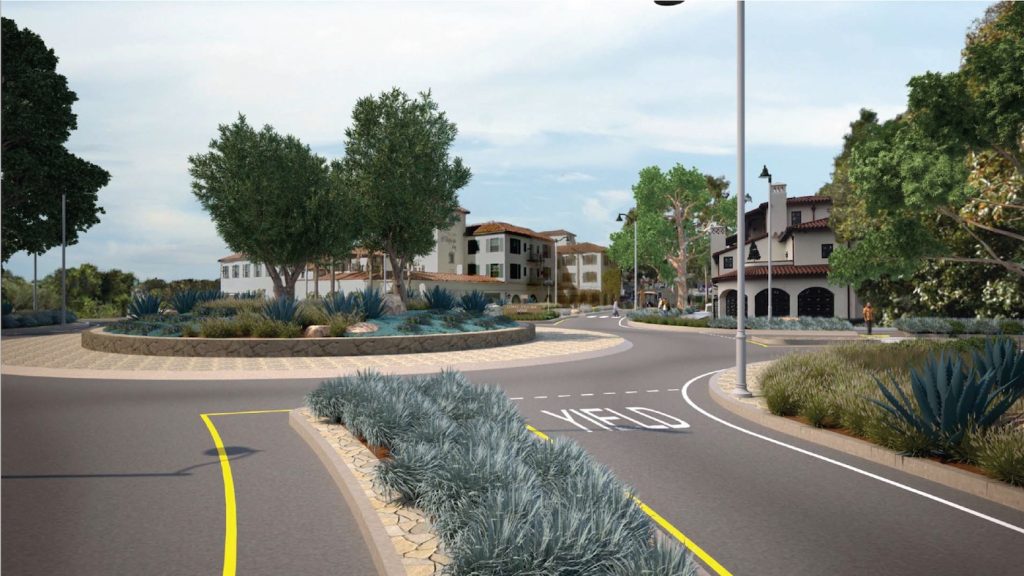
While motorists will be able to drive through the intersection throughout the entire construction period, project rep Kirsten Ayars reported back in August that the northbound off-ramp at Olive Mill Road will be closed throughout construction as the contractor is staging on the off-ramp. Drivers will be detoured to exit the freeway at San Ysidro Road. Also, the southbound on-ramp at Olive Mill will be closed from the beginning of construction through the end of the year. Drivers traveling south will be detoured on North Jameson Lane to the new on-ramp at Sheffield Drive. The Olive Mill Roundabout is a $9 million project funded by regional funding programmed by SBCAG.
In the spring, construction will begin on the San Ysidro roundabout. According to reps, by the time the construction starts, the Olive Mill roundabout will be able to be partially utilized and the southbound on-ramp to Highway 101 will be open, in order to lessen traffic impacts to the community.
The San Ysidro roundabout project includes replacing the current intersection at San Ysidro, North Jameson, and the Highway 101 northbound entrance and exit with an oblong-shaped roundabout, and adding a four-way stop on the other side of the freeway bridge, at San Ysidro and South Jameson Lane (near the Miramar Resort). The single lane roundabout will include pedestrian access on every leg of the intersection, including crosswalks that connect with paved walkways through the medians or refuge areas. The roundabout has enough space for bicycles to traverse the lane, or bicyclists can get off their bikes and walk in the pedestrian/sidewalk areas. The area will be heavily landscaped, per the conditions of the project, and signage is limited to coastal access and safety signs.
It’s anticipated that local streets could see five to 10 minutes of delay during various construction phases. The majority of the work will happen during daytime hours, with night paving slated for several nights.
Parklets
Another topic that garnered extensive coverage this past year was the debate about parklets on Coast Village Road.
In February, the Santa Barbara City Council adopted an ordinance that provided an additional 22 months, until December 31, 2023, for businesses within city limits – including on Coast Village Road – to operate expanded outdoor business facilities and parklets. The original Emergency Economic Recovery Ordinance was adopted in May 2020 in response to the emerging pandemic, allowing for restaurants to add outdoor seating without licensing requirements, as a tool to allow businesses to survive when they weren’t able to open indoors. That ordinance was then extended through March 8, 2022, allowing the parklets and outdoor dining throughout city limits to remain, despite the official “reopening” of California on June 15, 2021.
In response to our reporting on the extension, we heard from several local business owners and Montecito residents, all with differing opinions, who said they would like the opportunity to weigh in on the issue. When the parklets were first built on Coast Village Road in 2020, members of the community raised concerns about accessibility for those with disabilities, impact to surrounding businesses, emergency access, and cohesive aesthetics, and City staff brought the issues to City Council to discuss some possible changes to guidelines to address some of the concerns. Since the inception of the parklets, travel on sidewalks on Coast Village Road had become more difficult, and some retail businesses told us at the time that outdoor dining and parklets made their businesses less visible. The parklets utilized roughly 28 parking spots along Coast Village Road, which some business owners said was a problem for access to other businesses along the road.
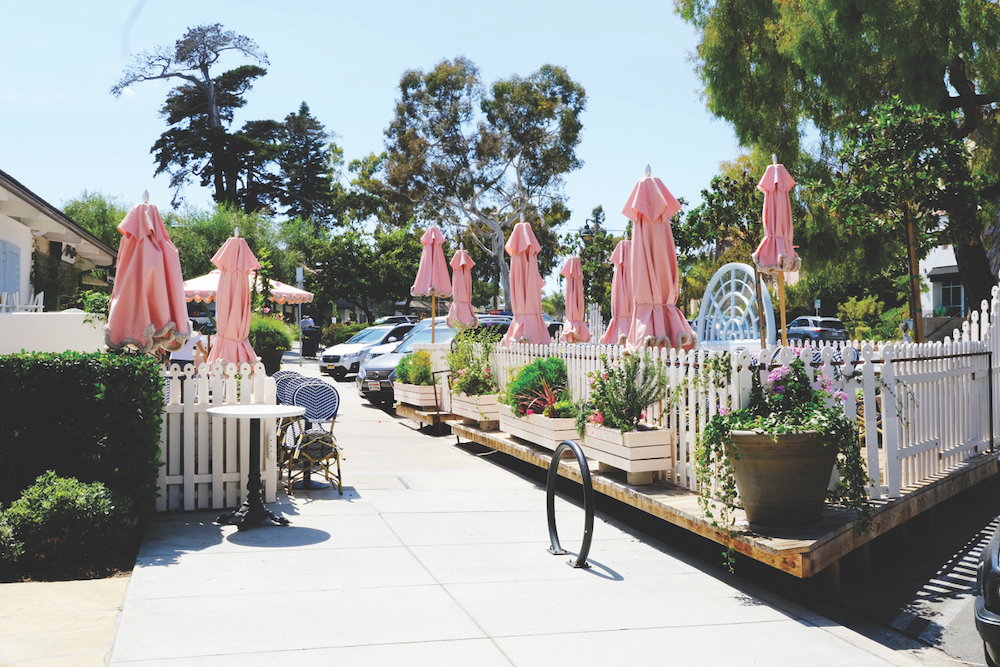
In August, a group of 30 business owners, property owners, employees, and restaurant patrons gathered at the conference room of Montecito Inn to discuss the fate of parklets. A letter sent to the Santa Barbara City Council in July, which was signed by over 25 Coast Village Road business and property owners, sparked the meeting, giving all stakeholders an opportunity to share feedback about the parklets.
Representatives from Tre Lune, Lucky’s, Bree’osh, Folded Hills, Coast & Olive, Tre Lune, Lucky’s, Maison K, K.Frank, State Farm, the Liquor & Wine Grotto, several property owners on the road, and Santa Barbara Mayor Randy Rowse all weighed in on the issue.
In September, City Administrator Rebecca Bjork sent a letter to stakeholders discussing the fate of the parklets on Coast Village Road. The City required new rules for parklets by the end of October, mainly, that they be limited to a maximum of two adjacent parking spaces in front of a business, and that they will be required to adhere to all other requirements of the City’s Economic Recovery Extension and Transition Ordinance (ERETO), including Americans with Disabilities Act requirements. For now, the parklets will be allowed to stay through December 31, 2023, but Bjork reports the City will revisit the issue in early 2023 to assess the impacts of the new rules. The City also intends on actively pursuing additional code compliance resources to assist in addressing parking violations along Coast Village Road; parking enforcement officers have been noticeably absent along the road for the last two years.
The letter stated that eight restaurants were currently utilizing the parklets, occupying about 28 of the 131 parking spaces on Coast Village Road. The parklets, which ranged in size from three to seven parking spaces, added approximately 253 additional dining seats to Coast Village Road.
All of the eateries who utilize the parklets have reduced the size of their parklets to a maximum of two spaces. Businesses report that parking has improved.
Randall Road Debris Basin
One of Montecito’s most important land-use projects came to fruition this past year: the Randall Road Debris Basin was completed.
In March, County Flood Control acquired the final, one-acre property in which to build the basin. After a lengthy delay, a recent ruling by the Ventura County Superior Court had given Flood Control the green light to continue building the basin, which is the largest debris basin in Montecito. The project was proposed along Randall Road in Montecito by private interests – mainly by nearby resident Curtis Skene – with the general support of affected property owners in the area, following the Thomas Fire and 1/9 Debris Flow in 2018.
The nine-acre project received approval by the Santa Barbara County Board of Supervisors in August 2020 and a $13.5 million grant from FEMA in November 2020. Back then the County began talks with the owners of seven properties on Randall Road and one on East Valley Road, and paid pre-debris flow market value for all but one of the lots, which were each about one acre in size. The final lot at 630 Randall Road belonged to Catherine Montgomery, who lost her husband Dr. Mark Montgomery and 22-year-old daughter, Caroline Montgomery, when the home on the property was swept away during the debris flow. In February she was ordered to release possession of the property via eminent domain. The 1/9 Debris Flow on January 9, 2018 took the lives of 23 members of the community, as well as damaged or destroyed nearly 500 homes.
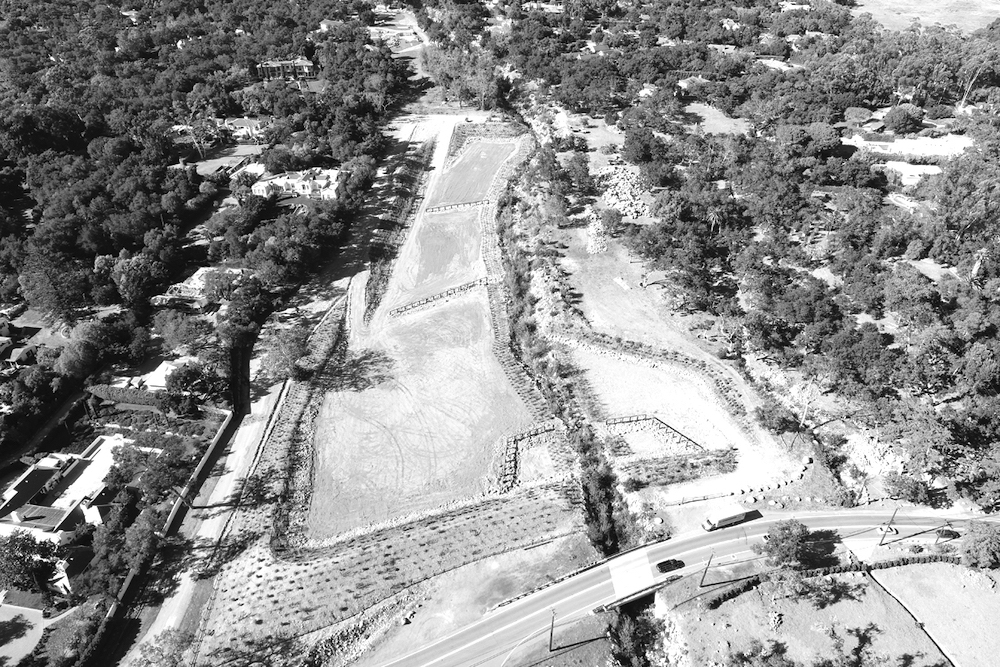
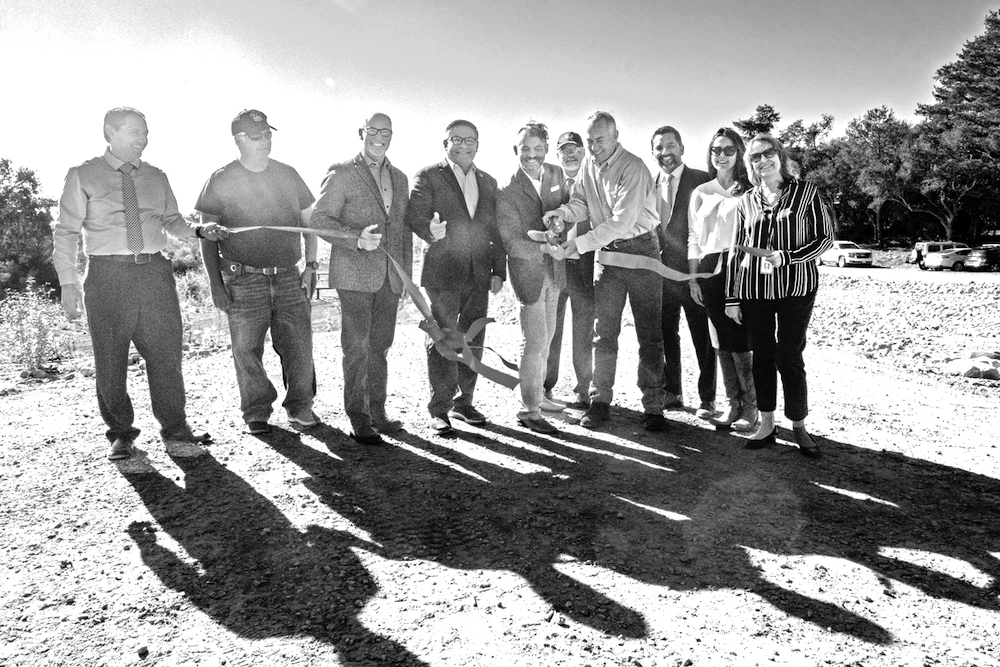
Construction on the debris basin commenced in May despite continued litigation regarding the last property, including a court venue change to Ventura County, requested by Montgomery. By March the rest of the project was finished, with the contractor, Vince Lopez & Sons, demobilizing their staging from the site in January. The pandemic and associated closures also played a role in the project’s delay.
On a brisk morning on October 24, government officials, staff, contractors, and community partners celebrated the completion of the basin. Stakeholders, neighbors, relatives of those killed in the debris flow, and former homeowners on Randall Road gathered to hear the short ceremony, which included speakers Congressman Salud Carbajal, First District Supervisor Das Williams, California Department of Water Resources (DWR) Manager Salomon Miranda, Public Works Director Scott McGolpin, and County Public Works Deputy Director Walter Rubalcava.
Future plans for the area surrounding the basin include walking paths for community members, and potentially a formal memorial for the 23 lives lost on January 9, 2018, in the debris flow.
The $21.3 million project was funded by a FEMA $13.5 million Hazard Mitigation Program Grant and a State $4.5 Community Development Block Grant.
School Happenings
As 2022 unfolded, we saw progress on major construction projects at both public school campuses in Montecito. Early in the year, we had a cover story on Santa Barbara Schools’ Superintendent Hilda Maldonado, in which MJ Publisher Gwyn Lurie had an exclusive interview with the relatively new superintendent, who talked about post-pandemic education culture, teacher morale, mental health, and the silver lining of the pandemic on education.
Cold Spring School
In February, we reported on Cold Spring School’s expansion project, which has long been a goal of the School Board, well before superintendent Dr. Amy Alzina’s tenure commenced in 2017. The board has long been focused on replacing the portable buildings on campus, which are nearly 30 years old and well past their useful life.
It was six years ago that the board voted to move forward with a new building to house classrooms and administrative offices; at one point, plans were in place for a 6,000-square-foot building to house three classrooms as well as the front office staff, and offices for school specialists. The Spanish-style building was to be the new gateway to the school, giving a place for visitors to check in before coming onto campus, which would serve to assuage a long-held security concern regarding the campus layout.
When the school was first built in 1889, the entrance to campus was along Sycamore Canyon Road, before it became a busy state highway. For safety purposes, a wall was erected at some point in the ‘70s or ‘80s, to protect the campus from the traffic; the entrance to the school was then moved east to the parking lot on Cold Spring Road. The office and administration building remained in the center of campus, causing visitors to have to enter the campus before checking in with campus officials, which has concerned many parents and teachers over the years. The proposed plan in 2016 also included improvements to existing infrastructure on the 100-year-old existing buildings include repairing or replacing roofs and restrooms, as well as repairing or replacing aging water/sewer lines, fire alarms, and schoolwide communication systems, and improving ADA accessibility, among several other maintenance items.

To fund the project, the board voted to seek a bond measure in November 2020: Measure L2020, which was for $7.8M, failed by a small margin. Following the failure, the board formed a Facilities Task Force, which includes 12 district residents including school parents, faculty, staff, and community members.
In June 2021, the Task Force issued a formal recommendation to construct a pared down, permanent building in two phases, beginning with two classrooms in Phase 1 followed by a third classroom and administration/office area in Phase 2. The new classrooms will be built next to the two portable classrooms near the entrance to the school; the new building will not replace the portables, yet. The first phase will cost about $1.6M, $1M of which will be pulled from facility reserves.
The Phase 1 classrooms will be utilized by STEAM and art classes, so the traditional, expensive build-out for a full-time classroom will not be necessary. The rooms will feel industrial, similar to a garage or workshop. Phase 2 of the project will cost an additional $2M, and will include one additional classroom, plus administrative offices, becoming the entrance to campus as desired in the school’s master plan. This will allow the library to expand into the current office space. The second phase of the project will be built where the portable classrooms are currently; it’s likely the second phase will require a bond.
Cold Spring School District residents have voted down two other ballot measures in recent years: In addition to Measure L2020 ($7.8M), Measure K in November 2006 ($14M) and Measure R in February 2008 ($8.75M) both failed. The last bond measure to pass was Measure C ($2.4M) in 2008, the funds of which went to renovate the seven older classrooms and two student restrooms in the main school building, as well as improvements to the play areas with a new play structure, blacktop, and new landscaping on the corner of Cold Spring Road and Sycamore Canyon. The remaining funds are earmarked to improve the utility infrastructure throughout the campus.
Dr. Alzina reported in February that enrollment has increased since the beginning of the pandemic, and because of the increase, special programs, including music, are housed in the school auditorium, and some special education programs are housed in the school library. “Space is as tight as ever. We need more classrooms. This problem is not going to go away,” she told us, adding that the enrollment at the school is growing from the ground up, with many families moving to Montecito with kindergarteners who will be at the school through 6th grade.

A state mandate that has required expansion of the Transitional Kindergarten (TK) program, which will eventually include all four-year-olds, regardless of when their birthdays are, has put added pressure on space limitations. The State requires that TK has a one to 12 student/teacher ratio. Current class sizes for the rest of the school range from one to 14 to one to 24.
In March, at a special board meeting, the Cold Spring School Board voted 4-1 to approve moving forward with a short-term loan to help fund the expansion project. The acquisition of the loan – and the financial position of the school in general – had been the subject of some community fodder on social media at the beginning of the year. The Certificate of Participation loan, a debt instrument frequently utilized in the education sector, will be repaid by the District’s General Fund over a 10-year period, potentially sooner. With an interest rate of 1.9%, Dr. Alzina said it was the most cost-effective way to “put shovel to ground” now, rather than waiting.
In May, the Cold Spring School District broke ground on the project with an enthusiastic groundbreaking ceremony. “It brings me great joy to see the hard work and dedication from the past and current Board and Administration finally come to fruition. It has taken the District sixteen years to get to this point,” said superintendent Dr. Amy Alzina, adding that a facilities strategic plan was created in 2006.
Dr. Alzina opened the groundbreaking ceremony with an all-school assembly open to parents and to the public. She thanked the current school board members, president Michael Marino, vice president Jennifer Miller, board clerk Eric Schiller, and board members Trevor Pattison and Gabrielle Haas for their support.She also thanked Parent Club President Zoe Copus, Foundation president Holly Kane, and the Building Bright Futures Chair Melissa McCann, for their leadership and fundraising efforts for the building. Yuri Calderon, the Chief Business Officer, introduced the architectural firm 19six Architects and architect Rachel Strange, a Cold Spring alumni. 19six is also the same architectural firm that designed the original 1927 Cold Spring School buildings.
Justin Boe, the project supervisor, assisted board president Marino and his kindergarten son, Benji Marino, with the first dig using an excavator. Board vice president Miller and Jake Miller, third grade student, were the next to break ground.
In November, the school was recognized for being ranked the top-performing district in the State of California in both English Language Arts and Mathematics (nearby Montecito Union School ranked #2). Dr. Alzina says that her school’s success in the standardized testing – 91.07% of students met or exceeded state standards in English and 92.79% in math – is likely due to the push to reopen the campus in September 2020, when many other schools across the state remained close and adopted in-home learning curriculum. Dr. Alzina said reopening the school after the 1/9 debris flow in 2018 offered stability and refuge to students, and, noting that, she and the School Board decided to open the campus in September 2020, albeit with new protocols and outdoor curriculum in place, despite the risks.
Also this year: the Association of California School Administrators (ACSA), a statewide organization that represents public and charter school administrators, recognized Mrs. Coral Godlis, Executive Assistant to Dr. Alzina, as the Confidential Employee of the Year for the State of California. The Confidential Employee of the Year distinction is awarded each year to a confidential employee that demonstrates exceptional leadership skills that represent the excellence and commitment of California’s educators. Coral was recognized at the Statewide ACSA Leadership Summit in San Diego, California, on November 4. ACSA recognizes school administrators and employees throughout California in 21 subcategories of awards.
Montecito Union School
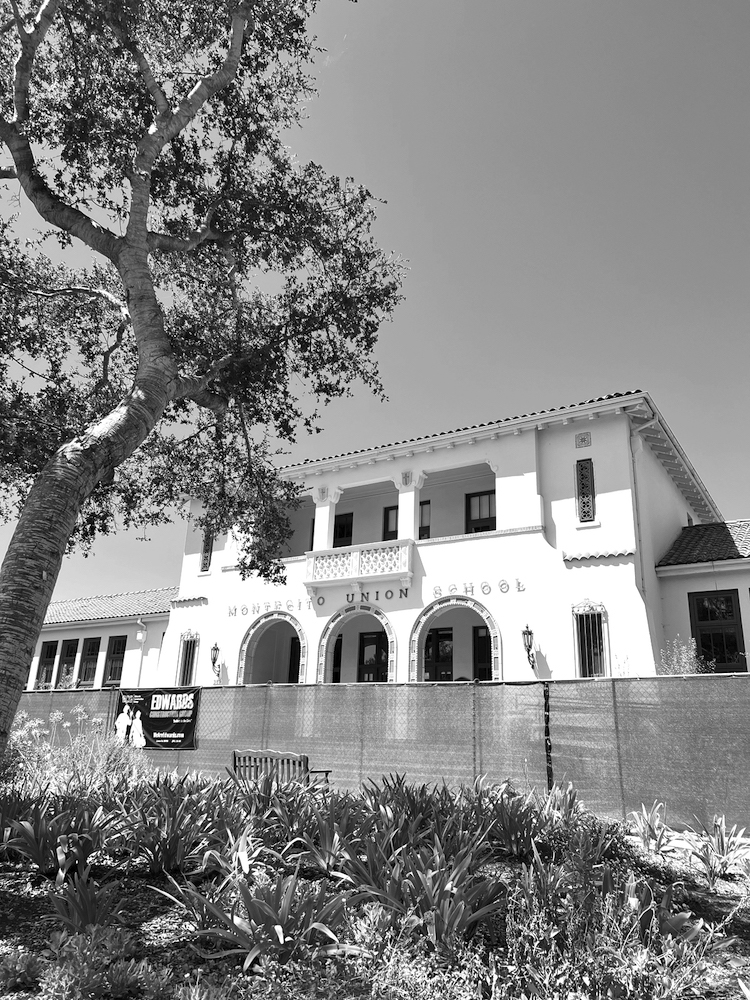
In August, just days before school went back in session following summer break, Montecito Union School reps were busy getting classrooms rearranged in order to accommodate what will ultimately be two years of construction in order to modernize campus infrastructure.
The facilities project, which is 15 years in the making, includes improving infrastructure and accessibility in Building D (over 100 years old) and Building E (over 70 years old). Because the campus is eclectic, the topography includes multiple levels, which means that there are multiple sets of stairs and non-compliance with ADA regulations. Two elevators will be added to the main building; new bathrooms will be added and existing ones will be brought up to code; thresholds will be modified to accommodate wheelchairs and walkers; truncated domes will be added where necessary for the visually impaired; ADA signage will be added; new built-ins will be installed where old ones are torn out during construction; and new equipment and some furniture will be purchased. Both buildings will also be outfitted with air conditioning, which the rest of the campus already enjoys. Newly-installed solar panels will generate the power necessary for the new HVAC systems.
This project will occur in five phases. Phase 1 was completed earlier this year, and included moving everything out of Building D, and bringing in eight, full-sized portable classrooms. A temporary office was set up in one of the fifth-grade classrooms, and other classrooms have been shuffled around. Fourth-grade classes, as well as music and one Spanish class, will be located in the temporary portable classrooms.
Superintendent Anthony Ranii, who gave us a tour of the campus in August, wants the community to know that the gate created in the fencing above the school on San Ysidro Road is not permanent, and is not a new entrance to the school. “We had to bring in the portables through this temporary access,” he said, adding that the portable classrooms, located on the field, could not be placed via School House Road because of the road’s narrowness.
Phase 2 has been in progress the latter part of the year, and includes all upgrades to Building D (the main building). From the outside, the building will look the same, but there is fencing up to secure the area during construction. Phase 3 includes completing the elevators, which Ranii says is the most complex part of the project.
Next summer the campus will be shuffled around again, with classes and administration going back to a newly-renovated Building D, and work beginning on Building E in Phase 4, which will displace TK, Kindergarten, and first graders to the portables. The final phase, Phase 5, which is anticipated in the summer of 2024, includes removing the temporary classrooms, renovating the field and hardscape, and moving everyone back to their original location.
The $14M project is being self-funded by the school and includes a $3M grant from the State of California. MUS has been aggressively putting aside money for this project, adding $700K-$1.5M per year to a special fund for the last five years. Earlier this year the School Board approved a bridge loan in order to secure the rest of the funds before lumber and construction costs inflate further.
Also happening on campus, a new school breakfast and lunch provider, NuCuisine Catering, is under contract for the year. Ranii said food service at the school has consistently scored low on parent and student feedback surveys, and that NuCuisine was chosen with the enthusiastic recommendation of a panel of teachers, staff members, parents, and students. Longtime executive assistant Autumn Noe has been instrumental in helping to transition to this new provider, which has created a food program that meets the needs and values of MUS.
NuCuisine Catering, owned by chef Koji Nomura, has been providing school lunch programs in Santa Barbara for 13 years. They currently serve lunch and breakfast at Riviera Ridge (formerly Marymount) and have also provided lunches for Bishop Diego High School and Hope School. Mr. Nomura has owned and operated Santa Barbara restaurants including Piranha Sushi Bar, Rocks Restaurant, California Noodle Kitchen, Miso Hungry, Santa Barbara Tennis Club, and was the Executive Chef at Oku Restaurant. The food program is free to all students.
Two new projects are also ongoing on the other side of campus, at the school’s Nature Lab. The newly-built Outdoor Learning Pavilion allows for science, art, and the preparation of fruits and vegetables from the Nature Lab.
For more information, visit montecitou.org. The campus is located at 385 San Ysidro Road.
Hellos & Goodbyes
Storefront shuffle: a look at who we welcomed and who we said goodbye to in our local business districts.
Coast Village Road

In February, we said goodbye to Here’s the Scoop (aka Scoops) owners Bob and Ellie Patterson, who operated their beloved Coast Village Road gelateria for 18 years. “Scoopie,” as the Pattersons lovingly referred to their successful business, was a feel-good staple on Coast Village Road, and the duo had become known for their tireless involvement in the Montecito community over the years, along with scooping their daily house-made gelato and sorbet for dozens of customers every day.
The shop opened on April 2, 2004, in the lower level of what’s now called Coast Village Plaza. Back then, the intoxicating scent of homemade waffle cones would waft up to Coast Village Road, luring customers down the stairs to the sunken patio. In 2017, the shop moved to the main level, attracting more foot traffic and positioned to be the go-to place for something sweet after dinner on Coast Village. The shop had always been adorned with artwork from local school children, which rotated monthly. A year after opening, the Pattersons purchased a mobile gelato cart to be able to serve gelato and sorbet at community events, including the Montecito Union School Carnival, Beautification Day, local tasting events, and private weddings.
The new owner, who wished to be out of the spotlight, lives in Montecito and continued to run the shop until October 31. Rumor has it that the new concept will be a nostalgic pharmacy or drug store, complete with an ice cream counter in order to keep the “Scoops” memory alive. We’ll have more on the new concept early in 2023.
In April we said goodbye to another long-term Coast Village business owner: Jeff Rypysc sold the Montecito Deli to Montecito restaurateur Gene Montesano, who, with the help of general manager Leslee Russell, opened the “Montesano Deli,” and later in August, the market next door.
The duo of businesses, Montesano Market & Deli, offers breakfast and lunch including egg dishes, traditional piadinas, classic and Italian sandwiches featuring D’Angelo breads, salads, prepared deli salads, and more, with the market offering an array of imported Italian products. From specialty canned and jarred tomatoes and tomato sauces, pestos, olive oils and vinegars, pastas and risottos, olives, beans, relishes, and herbs, to chocolates, sweets, and cookies, the pantry items are plentiful. There is also a refrigerated section that includes Italian butter, an array of cheese and cured meats, and more. The family-friendly shop also has a special kids’ shelf, featuring popular Italian kids’ products, as well as gluten-free pastas. The store is stocked with Montesano’s favorite items, and he is heavily involved in choosing the offerings, Russell told us at the time. The market also offers charcuterie boards and utensils, as well as picnic baskets, canvas totes, and napkins – everything you need to build a great gift basket or pack a picnic basket for the beach.
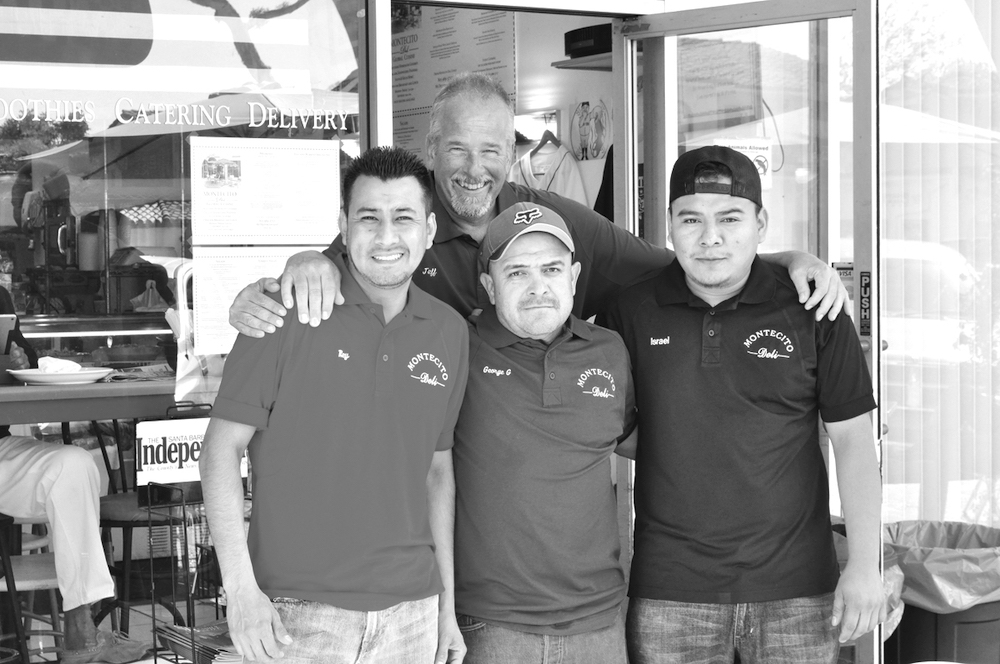
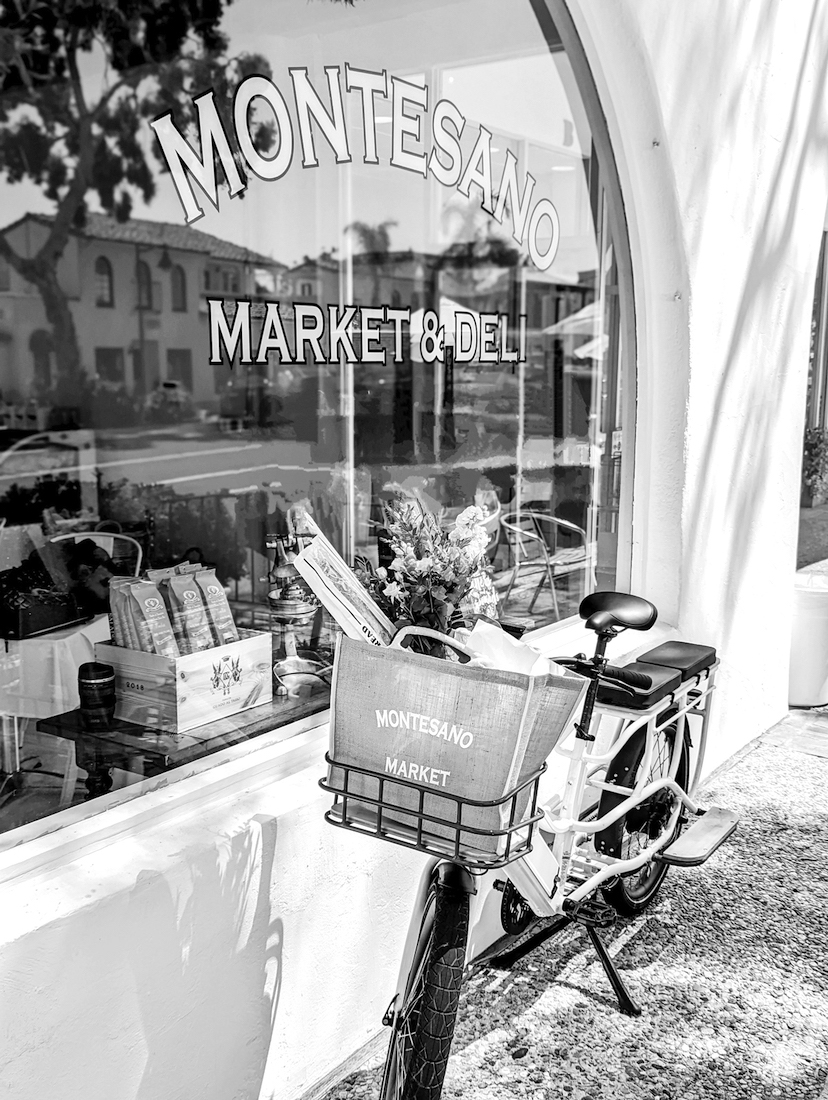

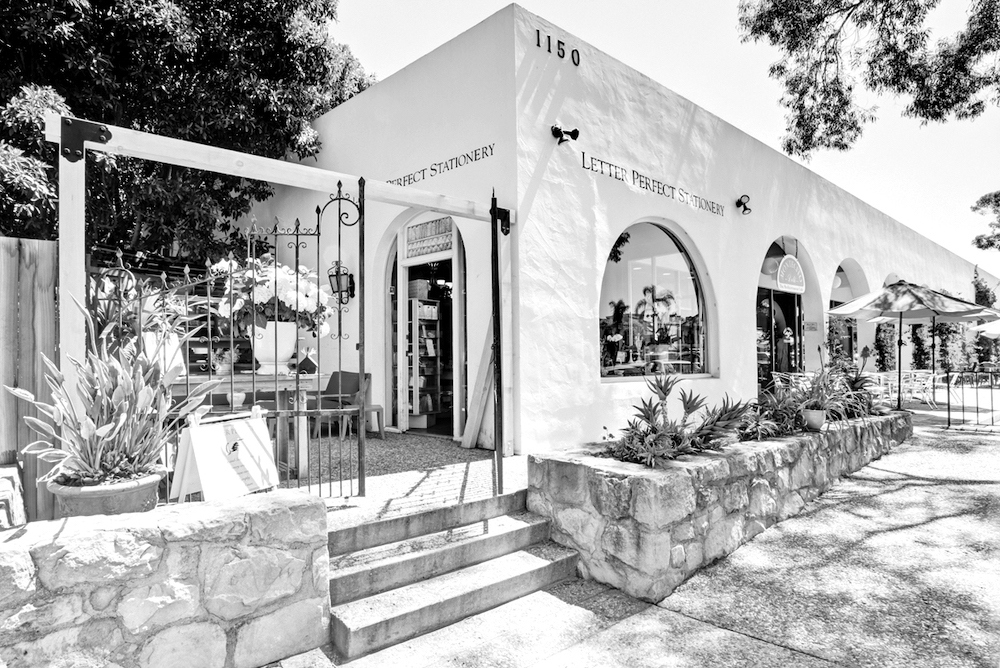
Montesano Market opened in the space formerly occupied by Letter Perfect, which closed in March. In June, owner Leslie Person Ryan opened a new iteration of the shop, Farm to Paper, in downtown Summerland, just steps away from the small, open-air farm cart she operates on Lillie Avenue. The shop is located in the former home of Lillette, an interior design business.

April also saw the soft opening of a new pet boutique catering to dogs, next to Folded Hills Wine Tasting Room. Cashy’s Playpen is the brainchild of New York City transplant Caroline Martel-Miller, who landed in Santa Barbara with her husband in 2020.
Martel-Miller is originally from Paris, France, and has a four-year-old French bulldog named Cash. The camera-loving dog has quite the following on Instagram, where Martel-Miller has documented the pup’s adventures, and gleaned inspiration from followers. Cashy’s Playpen offers toys, bedding, grooming supplies, wellness products, food, treats, home accent pieces, travel carriers, collars and leashes, and more. Brands are American-made and include Jax & Bones bedding, treats from Winnie Lou and Bocce’s Bakery, Maxbone travel carriers, Pride + Groom grooming supplies, The Foggy Dog bandanas, Fluff & Tuff toys, Wild One harnesses, Waggo home accents like water bowls and treat containers, and many more. “The majority of our brands give back to rescue organizations and dog shelters, which is really important to me,” Martel-Miller told us at the opening.
Also in April, Montecito Country Mart welcomed two new stores: DÔEN, the Los Angeles-based fashion and lifestyle brand owned by Santa Barbara-grown sisters Katherine and Margaret Kleveland, and Heather Taylor Home. DÔEN features the brand’s signature timeless and feminine ready-to-wear clothing, accessories, sleepwear, home, swim, and children’s styles. The sustainable clothing is made in India, utilizing vendors that support women.
Heather Taylor Home opened right in time for Easter, offering a line of home goods and textiles founded by Heather Taylor in 2013. Unable to find table linens that felt both fresh and classic, Taylor decided to make her own, which was inspired by her love of cooking, entertaining, and setting a beautiful table for gatherings with family and friends. The 100% cotton line has expanded to include pillows, bedding, and other accessories.



In May, Montecito’s first “meatless” market,PLNT PWRD MRKT, closed after less than six months in business. The concept was the brainchild of Tim Morton-Smith and his wife, Kamren, who found themselves buying plant-based items mostly online instead of in local stores; the goal of opening the market was to help other vegan and plant-based enthusiasts have a local place to get everything they need to live a meatless lifestyle. The market was co-owned with Sam and Lauren Benon.
A few months later, in October, Ready Set Confetti opened in its place. Montecito mom Emma Morton-Smith owns the new business, which offers an array of modern party décor and gifts from various on-trend brands. Ready Set Confetti offers party supplies in every color of the rainbow, as well as themed party sets, balloon garlands, wrapping paper, ribbon by the yard, holiday-themed items, and much more, as well as, of course, confetti.
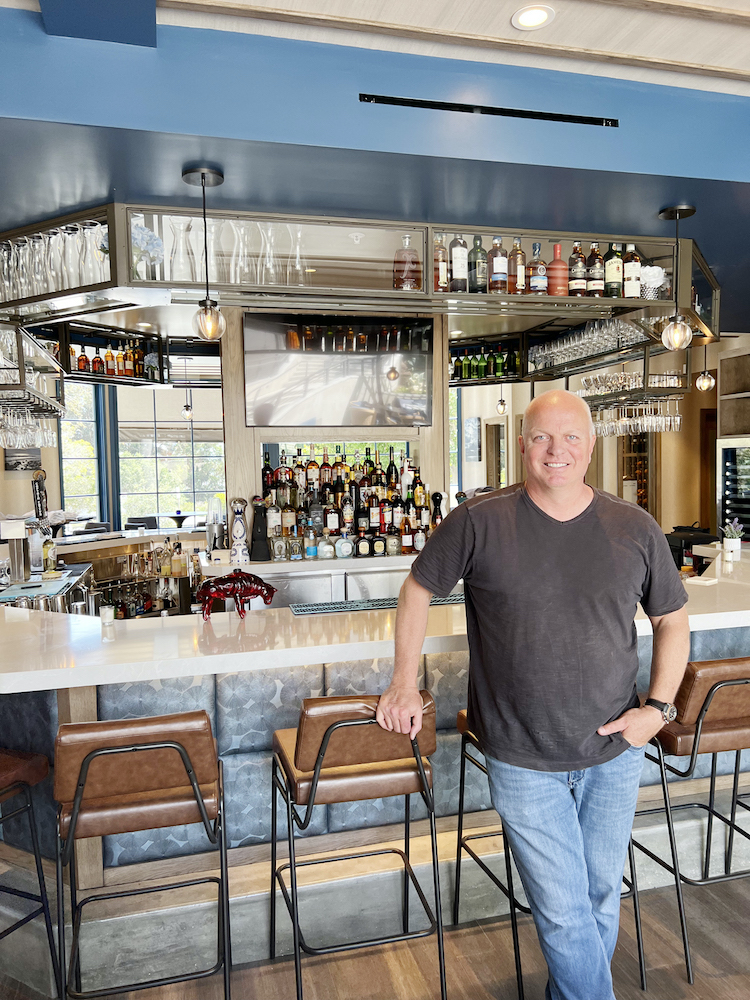
At Coast Village Plaza, we saw the opening of Local in April. The vibrant eatery is the brainchild of owner Michael Sheldon, who retired from his role as CEO of Goleta-based Curvature in 2017. Sheldon assembled a stellar team to help bring his ideas to fruition, including three high-level chefs to create the seafood heavy, Mediterranean-style menu. Sheldon told us at the opening that the menu was crafted from memories of the 50 best meals he’s enjoyed during his travels worldwide. After living in London, Switzerland, and New York, and traveling heavily during his career, Sheldon says he fell in love with food and wine.
The all-day menu features lunch and dinner favorites including an array of salads and sandwiches, fresh fish, cioppino, steak frites, brick chicken, and more. The menu is enhanced by nightly specials featuring the freshest ingredients. A raw bar features crudo, oysters, and other delicacies, and there are small plates, appetizers, and plentiful dessert options. The eatery offers a wine list featuring local and European options, as well as vintage champagnes from the ‘80s and ‘90s, an array of high-quality varietals, and house wines. A diverse liquor menu features scotches, aged bourbons, and more, as well as carefully curated cocktails.
Local utilizes both lower-level spaces on the property, one of which is the former home of Khao Kaeng (formerly Here’s the Scoop). That entire space was transformed into the restaurant’s massive kitchen, which allows elbow room for multiple preparation and cooking stations. The other space, at one time home to medical offices, was turned into an airy restaurant that showcases a stunning bar, complete with a baby grand piano and flanked by a wine room and private dining space. With bi-fold doors leading to the large patio area, the restaurant has an indoor-outdoor feel, capitalizing on the mild climate and beach house vibes of the furniture and décor. The patio, which is partially covered, can host 60 guests at once, while the entire space can accommodate about 140 patrons.
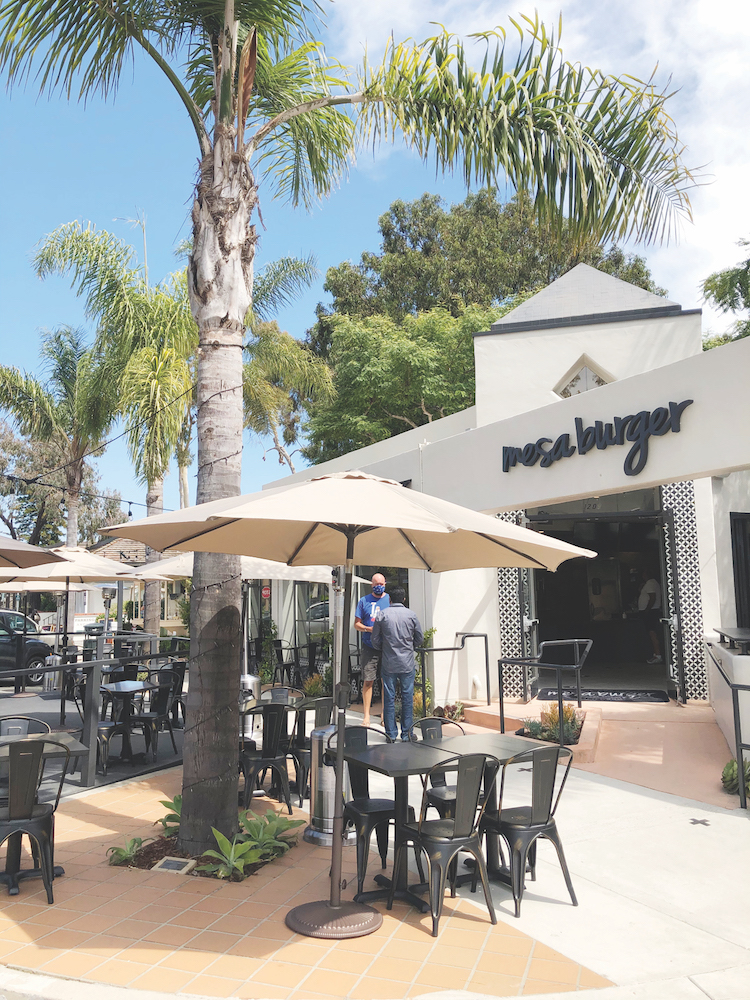
September marked the closing of Mesa Burger, owned by Chris Chiarappa. “It is with an extremely heavy heart that we are announcing the permanent closure of our Montecito location. We will be forever grateful to all our wonderful guests and the entire Montecito community for their gracious support. We will miss you!” Chiarappa said in a statement.
The burger joint opened in July 2020, during a time when indoor dining was restricted due to the pandemic. The original Mesa Burger, located on Meigs Road on the Mesa, was opened in 2016 by Chiarappa and celebrity chef Cat Cora, who was the driving culinary force behind the quick casual-yet-gourmet menu. The restaurant offers an array of gourmet burgers served on locally-made brioche buns, finished with scratch-made sauces and all the accoutrements, as well as salad and a kids’ menu. The Coast Village location, which was the former home of Coffee Bean & Tea Leaf, was in the works for over a year.
We expect that Lilac Pâtisserie, a dedicated gluten-free bakery and café, will open in the space in 2023. The bakery, which is owned and operated by chefs Gillian and Alam Muralles, has its first location on State Street, and serves breakfast, brunch, and lunch entrees as well as gluten-free cakes and baked goods.
Also in September: Montecito Med Spa opened on Coast Village Circle. Owned by Karen Neary, MSN, RN, the med spa offers a discreet, luxurious space in which to experience the latest innovative techniques for facial and body enhancements, under the care and expertise of clinical professionals.
With five treatment rooms, there is plenty of space to offer innovative therapies including EMSCULPT NEO, Potenza RF Microneedling, Elite IQ hair removal, TempSure Firm cellulite treatments, TempSure Envi treatments, FlexSure body boost treatment, HydraFacial, Liquivida IV therapy, and an array of injectables including Botox, Xeomin, Juvederm, and others. These treatments target concerns such as aging skin, sun damage, unwanted hair, wrinkles and fine lines, cellulite, and more.
Neary is joined by Aesthetic Nurse Giana Miller, who has been in the industry 19 years.

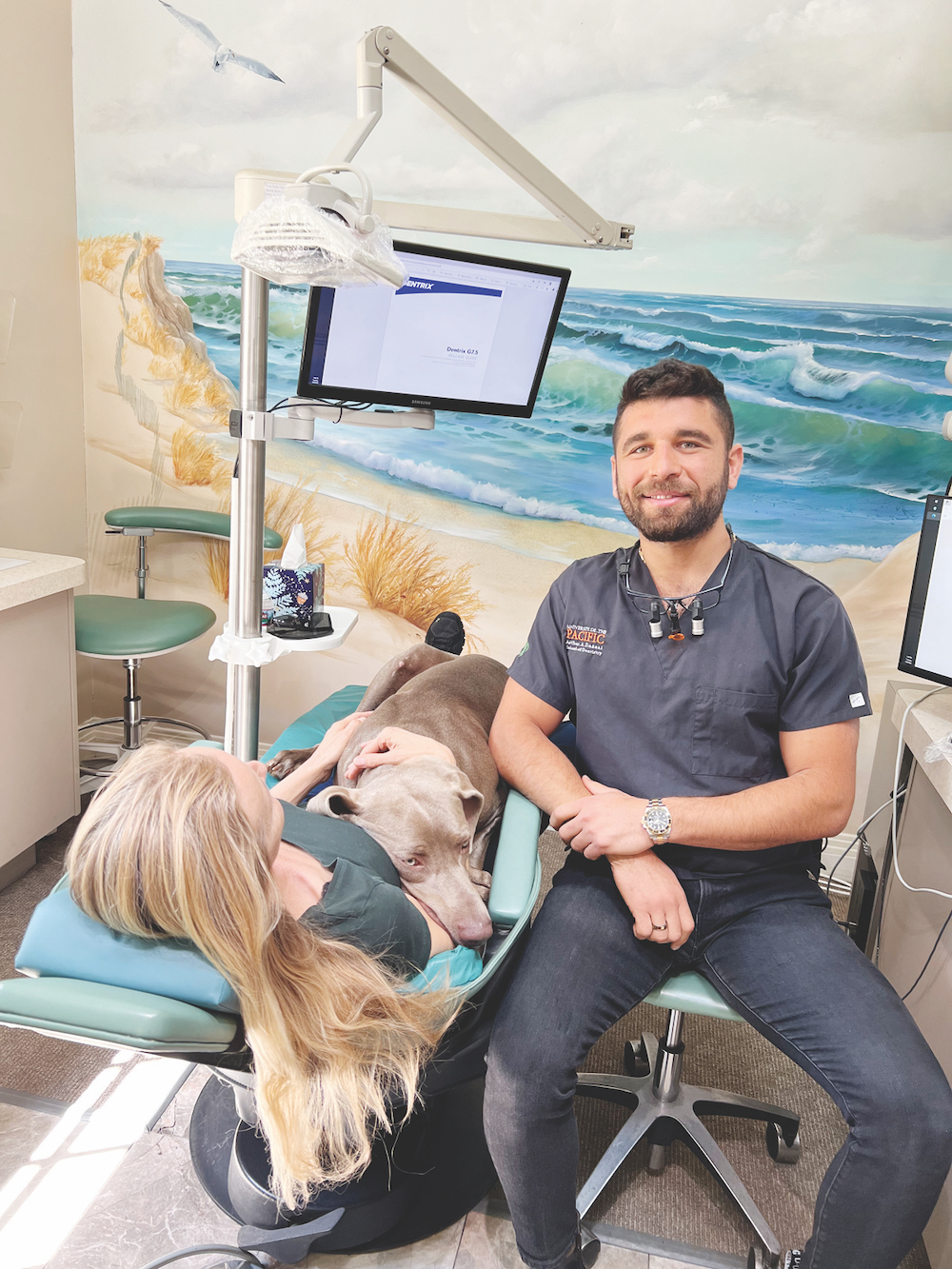
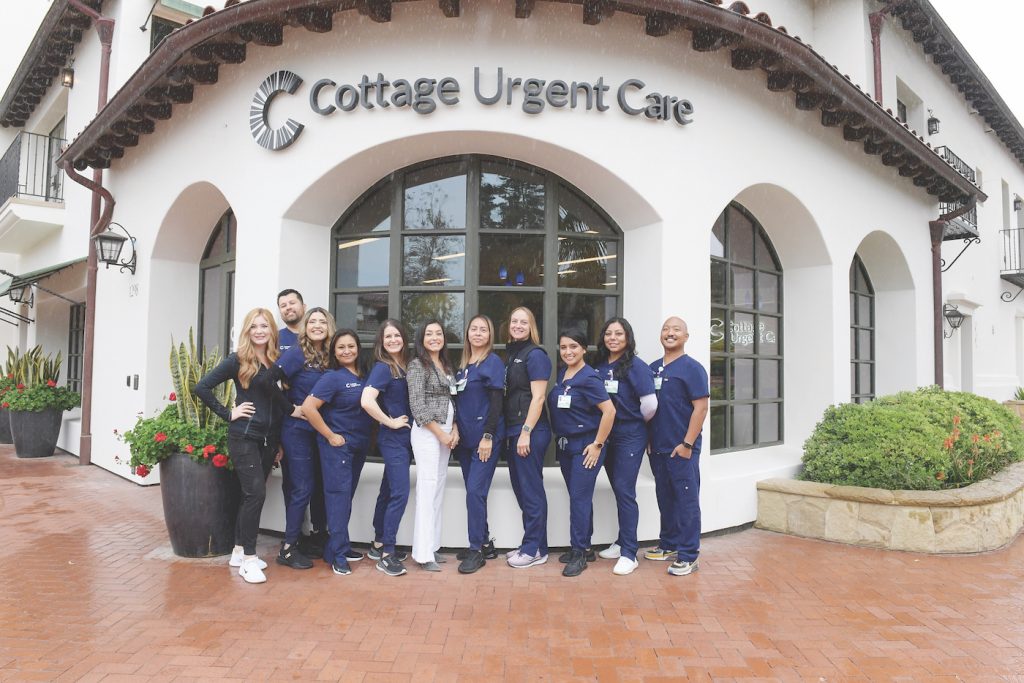
In November, Cottage Health opened its newest Cottage Urgent Care Center at 1298 Coast Village Road. Cottage providers staffing the Urgent Care Center include a licensed advanced practice provider (nurse practitioner or physician assistant), a radiology technician, and clinical concierges. Conditions treated include scrapes and minor cuts, minor burns, sprains, allergies, earache, urinary tract infection, skin conditions, rash, poison oak, cold and flu symptoms, COVID testing, and other minor ailments and injuries. Patients who require attention for more serious medical conditions may be referred to a local emergency department or physician. Available services onsite include X-rays and physical exams for student sports participation.
Cottage Urgent Care in Montecito joins 14 other Cottage Urgent Care locations in Santa Barbara, Goleta, Buellton, Orcutt, Santa Maria, and San Luis Obispo, as well as Ventura, Oxnard, Camarillo, and Point Hueneme.
Walk-ins are welcome and online appointments are available; it is the goal of the Urgent Care to provide complete care within 45 minutes.
On our radar for the future: we expect an overhaul of the Las Aves business complex on the corner of E. Cabrillo Blvd, Channel Drive, and Los Patos Way. The property sold earlier this year to a Los Angeles-based investment group to the tune of over $19M. The group, called the Runyon Group, has big plans to remodel the complex and bring in a fresh group of tenants to appeal to a younger demographic, according to a source close to the transaction.
No word yet on specific plans or timeline for Las Aves; it’s rumored the shopping and eating destination will be called The Post Montecito. With a new roundabout being built on the corner, and the location near the sensitive habitat that is the Bird Refuge, we surmise it could take many years to come to fruition. Current tenants at Las Aves complex include Loul Dental Studio, which opened in April, and Aesthetics Montecito, Points of Health, Beautiful You, and several other medical and office tenants. The complex is located at 1805 East Cabrillo Blvd.
Upper Village
In June, we did a feature on Kismet, the new business that took over the Glamour House location in the Upper Village. Owner Lindsay Eckardt opened the shop – her first retail store – when she and her family moved to Montecito. The newly-reimagined space has a similar offering to Glamour House (which is now available online), but targeting a younger demographic. Many of Eckardt’s customers have memories of shopping at Glamour House with their moms and grandmothers. Eckardt updated the store with plastered walls, new flooring, arched accents, and custom tile work. Kismet offers lingerie, loungewear, pajamas, and fine jewelry, as well as gift items for bridal showers, baby showers, and more. Brands include mostly women-owned companies including Fleur du Mal, Eberjey, Hanro, Jade Trau, EF Collection, Marlo Laz, and others. Eckardt calls Kismet’s curated collection of clothing and jewelry luxurious as well as approachable.



In July, one of Santa Ynez’s most popular shops popped up in Montecito’s Upper Village, located in the space once occupied by George Meta Jewelry near Montecito Village Grocery. Owned by Pearson and Spencer Turnbull, Santa Ynez General features its own brand of goods along with other lifestyle and clothing brands. The flagship location opened in downtown Santa Ynez in November 2019, with a second shop opening in September 2021. Both stores are located on Sagunto Street in Santa Ynez.
Jenni Kayne opened a second store in San Ysidro Village over the summer, located adjacent to her original apparel-focused Montecito store. Kayne has created a line of home goods in the same welcoming palette of timeless neutrals and grounded earth tones for which she is known; the store features furniture, including couches, beds, benches, outdoor furniture, credenzas, cedar stumps, and chairs, as well as textiles including pillows, blankets, and towels, and tabletop items such as plates, utensils, and décor. Kayne has also partnered with a few other home brands to offer in-store, including Crow Canyon, Olive Atelier, and Victoria Morris.
The store is the third brick and mortar to offer Jenni Kayne’s home products. It’s located at 525 San Ysidro Road in Montecito. For more information, visit jennikayne.com.
Montecito Milestones
Montecito Association Happenings
At their first meeting of 2022, the Montecito Association Board of Directors welcomed returning directors Aimee Miller and Robert Kemp, and new directors Leslie Lundgren and Stan Roden were appointed to fill empty seats. Lundgren, a fifth-generation Montecito resident, has a keen interest in history as well as preservation of Montecito’s semi-rural ambiance. Roden is a trial lawyer who has spent most of his life in Santa Barbara and Montecito.
Two seats were also up for grabs for one-year terms, as Jeffrey Schlossberg and Marshall Miller left the board before the end of their terms in 2021; Miller is now on the Montecito Planning Commission and Schlossberg stepped down due to time constraints. Appointed to fill those vacancies were Inken Gerlach, a Montecito resident with a background in engineering, and Cheryl Trosky, a longtime Montecito resident with a background in nursing who most recently served on the Citizens Independent Redistricting Commission.
Retiring directors included Cindy Feinberg, who once served as president of the Association, and Kathi King, longtime treasurer and Village Fourth co-chair.
The 2022 slate of officers was also announced at the annual meeting: Megan Orloff as president, Doug Black as vice president, Houghton Hyatt as second vice president, John Murphy as treasurer, and Penny Bianchi as secretary.
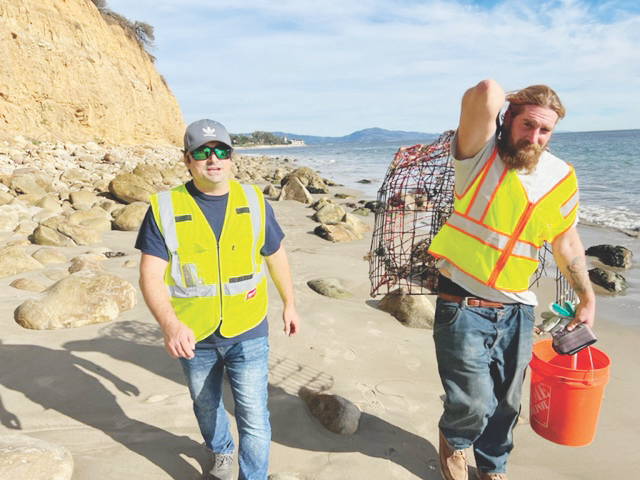
The Association, with the help of Executive Director Sharon Byrne, kept a busy year, filled with involvement in homeless outreach, lobbying, planning events, and keeping tabs on local projects.
In February the Board was briefed on the MA’s Hands Across Montecito (HAM) project, which was launched in 2021 as a pilot program to help provide outreach and resources to homeless people living in Montecito. Homelessness country-wide has increased since the pandemic began in March 2020; at the time the program launched there were about 30-50 homeless living in Montecito in various encampments near the Bird Refuge, Hot Springs freeway exit, near the Pointe Market on Coast Village Road, the area near the freeway and Coast Village Circle, the area between Olive Mill and San Ysidro roads, and near the railroad tracks near Montecito Shores and Bonnymede. HAM partnered with outreach coordinators from City Net, an organization comprised of a team of nonprofit professionals who work to end street-level homelessness. Founded by Brad Fieldhouse, the organization was already working in the City of Santa Barbara and partnering with Cottage Hospital to get local homeless the medical help they need.
Byrne gave an extensive PowerPoint presentation on the project, which exceeded everybody’s expectations in terms of number of volunteers – nearly 20 people – who donated time, money (roughly $123,000), and resources, as well as number of homeless people helped. It’s estimated that there are fewer than five people currently living unsheltered in Montecito. The project included multi-camp cleanouts, countywide partnerships, and the trailblazing of a new way to provide resources for the homeless population that could very well be used for other communities trying to tackle this issue.
Later in the year, Byrne helped organize multiple cleanouts of abandoned homeless encampments, which she documented here in the pages of the Journal.
In June, the MA tackled the issue of Pacaso, a Bay Area-based company that buys homes and then sells fractional interests in them to second-home buyers. After the sale – in which the company makes a profit – the company then manages the home, and the co-owners use Pacaso’s technology to schedule time in the home. The company had acquired two homes in the Santa Barbara and Montecito areas: one on Las Alturas on the Riviera which sold for $1,085,000 for a 1/8 share and one on East Valley Road in Montecito, which sold for $1,294,000 per 1/8 share. Some neighbors of the Las Alturas home were not happy, and articles in other local publications told of disgruntled neighbors who complained that the home was being utilized as a place for owners to vacation, have large parties, and not have ties to the neighborhood or community.
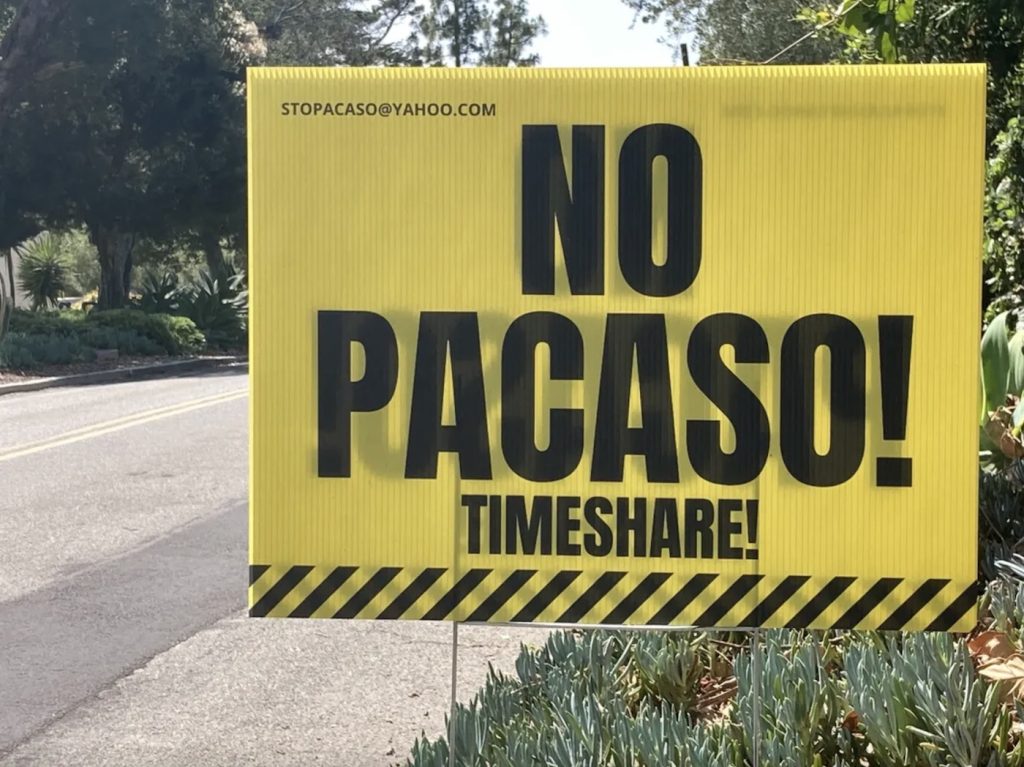
Don Vogt,an outspoken neighbor of the Las Alturas property, told the MA board that the Pacaso business model essentially operates as a short-term occupancy timeshare, which has a negative impact on local neighborhoods. According to Vogt, the company takes a single-family home off the market for a potential buyer who would be living there full time, which adds to housing woes, adds more traffic to narrow streets, and takes a home off the market for a family or individual who would likely work in the area. Vogt and his wife, Carolyn, asked the Montecito Association to get involved with helping to lobby the City Council and Mayor Randy Rowse to enact changes to local ordinances to halt fractional ownership. At least 12 cities are attempting to change their local ordinances to take action against timeshares and Pacaso’s fractional ownership models. Sonoma and St. Helena in California’s wine country are the two cities at the forefront of this ban; both have already amended local codes banning the use of a home as a timeshare outside of commercial zones.
Members of the Board and audience brought up such issues as compounding the already tight housing market by taking available housing and selling it to out-of-towners, adding traffic and cars to high-fire areas, negatively affecting property values for homes located next to a Pacaso, short-term occupancies creating a nuisance to neighborhoods, and a loss of transient occupancy tax to the County. The Board unanimously voted to do two things: 1) Begin education and dialog with the Montecito community about the impact of Pacaso on the community, its infrastructure, sense of community, and long-term value, and 2) Explore potential partnerships with other local advocacy groups to lobby for local ordinances and/or updates to existing ordinances that will help protect Montecito and partner communities.
In July, the MA pulled off another successful Village Fourth motorcade. From the flyover of vintage planes that kicked it off, to a slew of historic autos in the Loudest, Proudest motorcade, all festooned with July 4th decorations, the Grand Marshall Diane Pannkuk, the Sheriff’s Paddy Wagon, Dana Newquist’s 1937 Fire Engine / Wonkamobile, Adam’s Angels on the Trolley, to the after-party on the lawn in front of Via Vai, it was a spectacular day of honoring our country.
Also in July: Montecito Association hosted the California Department of Insurance and agents from Brown & Brown and Bridgepoint, to discuss the insurance issues facing Montecito residents.
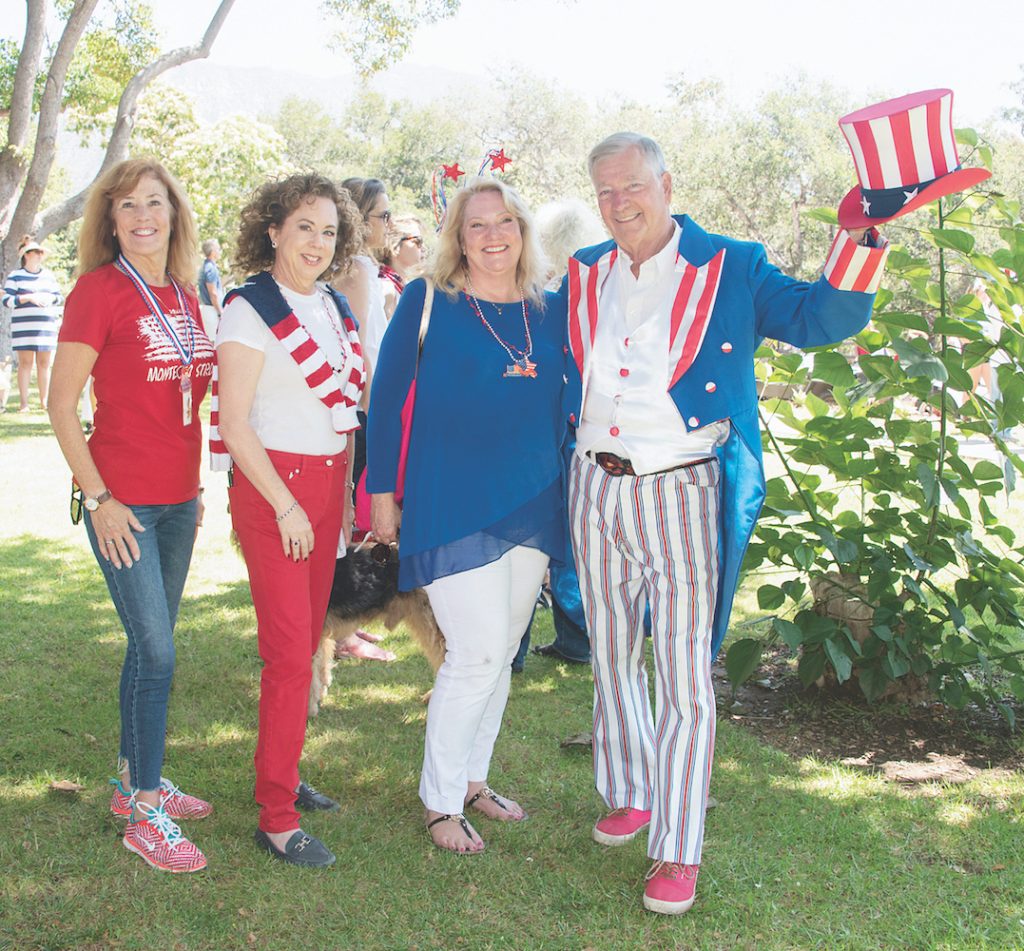
In September, it was announced at a Montecito Association Board Meeting that license plate cameras will soon be installed in Montecito as a pilot program. Santa Barbara County Sheriff’s Deputy Craig Bonner said at the time that the technology will be utilized to help law enforcement solve significant crimes, and will not be used for traffic enforcement. If a vehicle is identified as being part of a crime, the license plate will be entered into the system and if the vehicle drives by one of the plate readers, sheriffs’ deputies will be notified. The technology has been implemented in other areas of the country and has helped to recover stolen property, kidnapping victims, and helped to find at-risk people.
In October, the MA’s Land Use & Transportation Committee was briefed on two conceptual projects in Montecito as part of the County’s Active Transportation Plan. the Committee heard from Santa Barbara County’s Alternative Transportation Manager Mark Friedlander and Public Works Director Chris Sneddon.
The Active Transportation Plan (ATP) is part of the County’s One Climate Initiative, which includes action plans for housing, transportation, adaptation plans, and environmental justice in relation to climate change. A steering committee for the ATP set out last year to understand multi-modal transportation movement throughout the County and identify viable and implementable infrastructure that improves access, equity, and mobility while reducing collisions and emissions. After identifying high priority areas, the group looked at locations such as schools, transit stops, and parks, and overlaid it with data from collisions involving pedestrians and cyclists who were killed or severely injured. Brainstorm sessions for improving multi-modal access were held throughout the county last year, including in Lompoc, Cuyama Valley, Santa Maria Valley, South Coast North, Santa Ynez Valley, and the Santa Barbara South Coast.
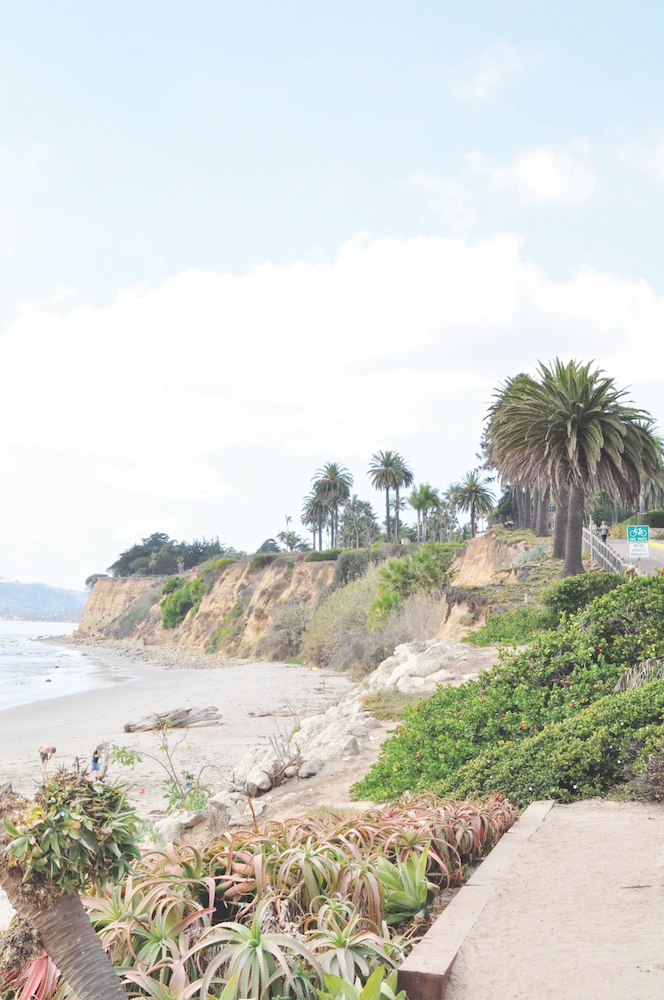
Feedback from Montecito residents includes a general need and desire for better facilities like sidewalks, signage, and beacons. Two potential projects in lower Montecito have emerged from the public outreach and data collection: the Channel Drive Bike Boulevard and the Danielson Road/South Jameson Lane Bike Boulevard. The Channel Drive project would extend the Channel Dr. bike corridor from the eastern end of the Class 1 path to Olive Mill/Virginia Rd., and include traffic calming measures such as on-street markings, signage, etc. A decomposed granite pathway along the south side of Channel Drive is also proposed, connecting the existing Class 1 path with beach access. The Danielson/South Jameson project would include a bike boulevard, bike lanes, and pedestrian path connecting Channel Drive with Eucalyptus Lane to create a safe, traffic-calmed east-west pedestrian and bike corridor. There would be improvements to crosswalks by All Saints-by-the-Sea Church, including a curb bulb-out on the west side of the crosswalk to improve visibility around an existing tree.
The projects are both in very preliminary conceptual review and would likely not come to fruition until after the 101 construction is complete. The projects will be funded by federal, state, and local grant funds. We’ll have much more on these projects as they progress.
November’s Board Meeting tackled the topic of a ballot initiative aimed for 2024 that would amend the California constitution to prevent new laws that override local zoning and planning jurisdiction, such as Senate Bill 9, which passed in 2021. SB9 became effective January 1, 2021; the controversial bill is in response to Governor Gavin Newsom’s goal to add millions of housing units in California. SB9 allows the building of multi-family housing units in single-family residential zones, via ministerial approvals only, which opponents fear could lead to a gross over-development in neighborhoods throughout California. In addition to drastically reducing the red tape to build multiple units on a property, SB9 also allows lot splitting, potentially enticing developers to buy properties, demolish them, and build new housing units. SB9 does not require that improvements be made to local infrastructure to accommodate more residents, including water and sewer infrastructure, law enforcement and school capacity, road infrastructure, and more. These projects are also exempt from CEQA, which means no environmental review is required.
The thousands of neighborhood leaders in California behind this new initiative, called Our Neighborhood Voices, believe that more housing is needed that is affordable for middle- and lower-income Californians, but that by taking control away from local jurisdictions, it allows developers to build lots of expensive, vacant housing units that very few Californians can afford.
Also in November, the Montecito Association hosted another successful Beautification Day in the Upper Village. Hundreds of volunteers participated in picking up litter along Montecito’s trails, roads, and beaches, donning special safety vests – rather than t-shirts – and pick-up sticks. The family-friendly event began with a continental breakfast provided by Andrea Newquist and Jacqueline Duran.
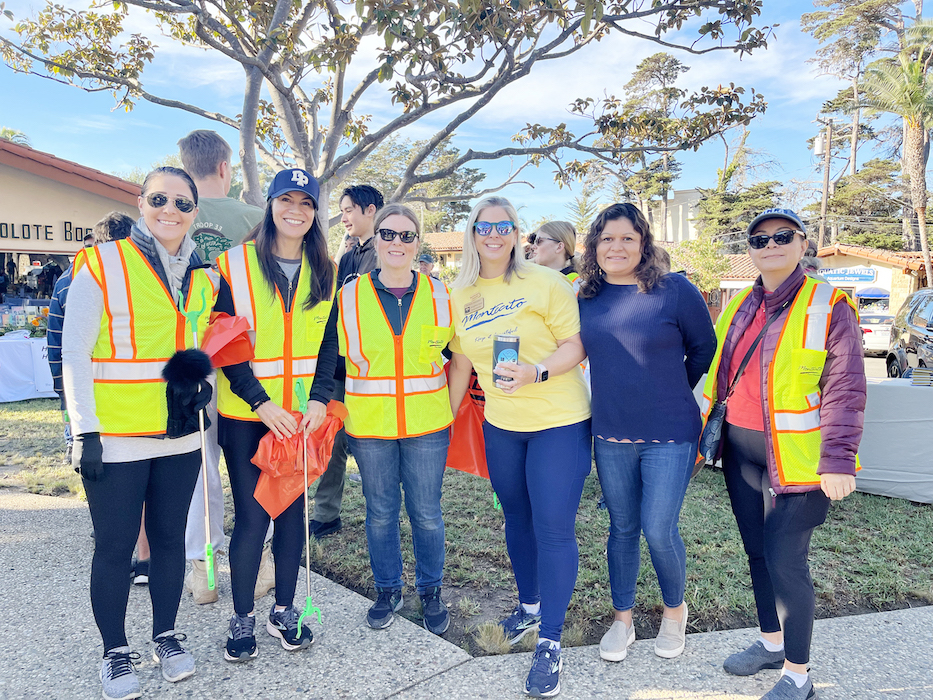
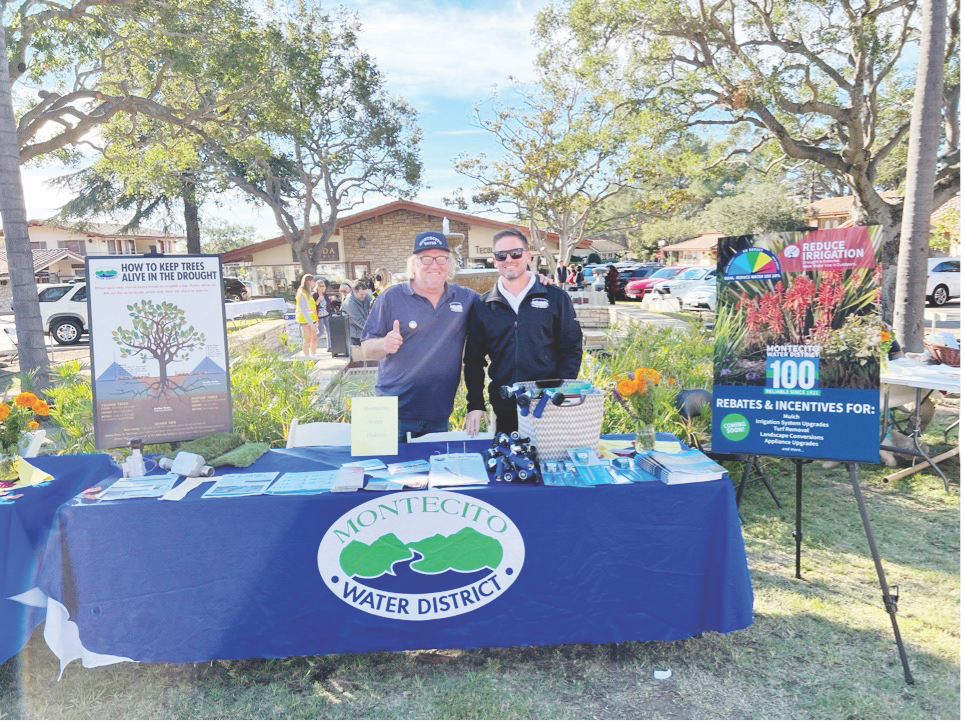
After litter pick-up, volunteers returned to the Upper Village Green around 11:30 am, where there was a short awards ceremony where two Citizens of the Year were announced: Kathi King, who has worked with the Community Environmental Council, served on the Montecito Association Board, and chaired the Village Fourth; and Mike Clark, the Montecito Water District’s Water Conservation Coordinator.
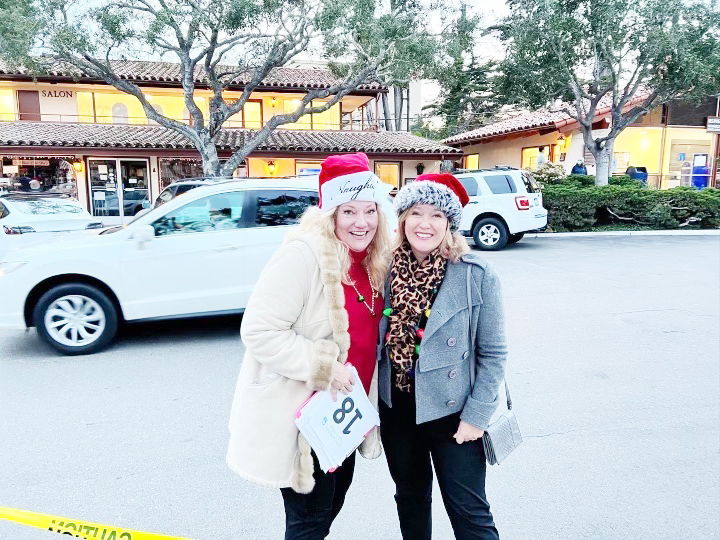
Lunch was provided by Montecito Village Grocery and San Ysidro Ranch, and was prepared and served by Montecito Firefighters.
This year’s Beautification Day was chaired by Houghton Hyatt and the committee included Mindy Denson, Michael Edwards, Cindy Feinberg, Dana Hansen, Berna Kieler, Lisa Waldinger, Sharon Byrne, Andrea Newquist, Jacqueline Duran, Nina Terzian, Jean von Wittenburg, and Patty Rich Zucherman.
In December, the MA hosted the second annual Holiday Magic Parade, where a parade of vintage and decorated cars paraded through the streets of Montecito. Special thanks to Sharon Byrne to organizing the festive event, which went off without a hitch.
The monthly board meetings of the Montecito Association continue to be the place to learn about lots of community happenings, including new construction, school happenings, local crime, and more.
The meetings are held the second Tuesday of every month, via Zoom. Visit www.montecitoassociation.org for more info.
Montecito Planning Commission
At their first hearing of the year, Montecito Commissioners voted unanimously to appoint commissioner Ron Pulice as the chair of the Commission. While there was some discussion about Pulice’s current non-resident status – he currently resides elsewhere in the county – it was decided that Pulice would be able to finish his term. Commissioners Susan Keller and Marshall Miller were appointed First Vice Chair and Second Vice Chair, respectively. Bob Kupiec and Donna Senauer also sit on the Commission.
The Commission discussed multiple projects and issues, including SB9, which allows the building of multi-family housing units in single family residential zones as well as lot splitting via ministerial approvals only. The Commission also weighed in on the 101 widening project over multiple months, reviewing design features, the issue of sound wall removal, landscaping, construction staging, and more.
Over the year the Commission heard and made decisions on several new residences, new pools, new ADUs, additions, and more. They also considered additional burial plots at the Santa Barbara Cemetery, the flow of the San Ysidro Road intersection, and received a briefing on the maintenance of the debris flow nets, which were installed following the 1/9 Debris Flow.
Montecito Board of Architectural Review
The Montecito Board of Architectural Review (MBAR) has had a full docket as well over the last year, hearing on average 8-15 projects at each of their bi-monthly meetings.
The scope of these projects ranged from new trellises and placement of outdoor lighting fixtures, to new garages, ADUs, guest houses, pools, cabanas, outdoor kitchens, sports courts, and additions, all the way to demolition of existing homes and building of completely new residential projects – as well as a handful of commercial projects, like the YMCA remodel, alterations to the Westmont College campus, alterations to the Montecito Firehouse on Sycamore Canyon, addition of utility poles on Sheffield Drive and S. Jameson, and minor alterations to the Miramar Resort – in the Montecito Community Plan area.
The Board also reviewed the Highway 101 project and associated roundabouts multiple times, helping planners hone in on the ideal aesthetic for Montecito.
The Montecito Board of Architectural Review meets two Thursdays per month via Zoom. The eight-person board includes Chair John Watson, Vice Chair David Mendro, Supervising Planner Kimberley McCarthy, and board members Bill Wolf, Claire Gottsdanker, Don Sharpe, Thiep Cung, and Alida Aldrich, as well as Secretary Sharon Foster, who retired in December. For more information on this project as well as others making their way through the planning pipeline, visit www.countyofsb.org/plndev/hearings/mbar.sbc.
Coast Village Improvement District
This year was an exciting time for Coast Village Road businesses, property owners, and residents. In June, the Santa Barbara City Council voted to establish and form the Coast Village Community Benefit Improvement District (CBID), an idea that has been in the works since November 2020, brought forth by the Coast Village Association (CVA). The resolution came after a tallying of votes cast by Coast Village Road property owners, of which the majority voted in support of the CBID, which will allow local control of the street’s aesthetics, safety, and marketing ventures, filling the gaps in service from the City of Santa Barbara, which governs Coast Village Road. The CBID will be funded by property owners as an additional tax assessment.
“It is the most profound public/private partnership that, I believe, Santa Barbara has ever embraced,” said CVA Board President Bob Ludwick, who was instrumental in the CBID process. “The local government has trusted this business community to shape and sustain its own future, and I could not be more thrilled.” The project has been a labor of love for Ludwick and a committee including CVA Vice President Rob Miller and Board Members Trey Pinner, Rick Lemmo, Francois DeJohn, Thorn Robertson, and property owner Jeff Harding, along with consultant New City America, which has helped groups like the CVA form CBIDs across the country, including San Diego’s Little Italy and Los Angeles’ Chinatown.
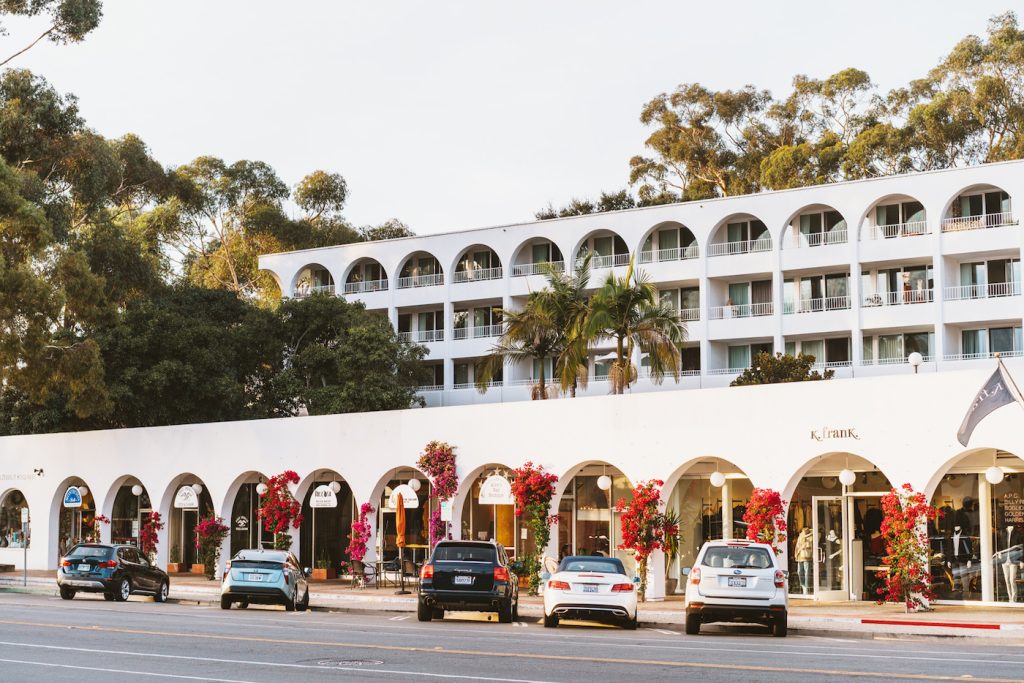

The expected assessments to the property owners on Coast Village Road, 78% of whom (weighted) were in favor of the CBID, range from a few hundred dollars per year to $19,000 per year, with the average falling around $1,800. The funds, which total about $300K the first year, will be used for private security to help with the unhoused population and panhandlers in the area; much needed beautification of the road; branding and promotion of the road; events such as Taste of Coast Village; social media and marketing; parking attendants; traffic management; and more. Next steps include forming a 501(c)3 and creating a newly constituted Board of Directors, which could be as many as 15 people, 2/3 of which will be required to be property owners. Ludwick will not be part of that Board, as he has announced his retirement from the Coast Village Association.
In October, the Coast Village Association was officially dissolved. Since its resurrection about six years ago, the Coast Village Association had worked to promote business along the street through social media campaigns and events, including the popular Taste of Coast Village in 2019 and the Virtual Cash Mob event at the beginning of the pandemic shutdown in 2020, in addition to annual holiday decorating contests, member mixers, and more.
“I’m really excited about this as a model for other business districts and a way to invest in your own community,” said District 4 City Councilmember Kristen Sneddon, who represents Coast Village Road. “I have so much appreciation for your efforts.”
For more information about the CBID, visit coastvillageroad.com.
Also in October, the annual trick-or-treating event Ghost Village Road went off without a hitch, as local retailers participated with massive decorations, goodies, and costumes. The cloudy, overcast skies lent to the atmosphere for the throngs of local school kids. Popular costumes included Tom Cruise/Top Gun, Star Wars, fantasy heroes, princesses, and overtime on inflatables – with candy still being a top priority.
Local Elections
As always, we provided extensive coverage of the November elections, including endorsements.
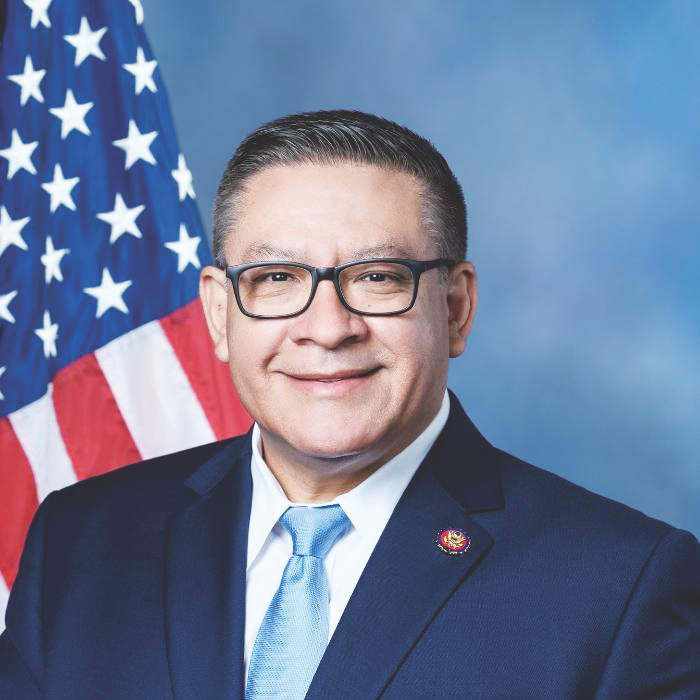
We congratulated Congressman Salud Carbajal, who continues to traverse the country between his hometown Santa Barbara and our nation’s capital, fighting the good fight for all of us on the Central Coast and beyond.
In Santa Barbara County, a complicated game of musical chairs ended with County Supervisor Gregg Hart dancing off to Sacramento to serve in the State Assembly with reelected Governor Gavin Newsom – leaving his BOS District 2 seat in the capable hands of School Board Member Laura Capps. Gabe Escobedo will, in turn, waltz onto Santa Barbara Unified School Board representing District 1, the first ever “minority-majority” district in Santa Barbara Unified’s history.
As for Montecito, we have a new member on the Santa Barbara City College Board of Trustees in local resident Charlotte Gullap-Moore. Incumbent Marybeth Carty will continue her hard work on the Santa Barbara County Board of Education, and Peter van Duinwyk will return to warm his seat on the Montecito Fire board, joined by self-identified “techie” newcomer Steve Dougherty. Meanwhile, two Cold Spring School District School Board incumbents, Board Chair Michael Marino and Board Member Jennifer Miller, despite years of controversy with some vocal community critics, have been given the nod to keep calm and carry on. They will be joined on the Board by parent and newcomer, Elke Kane.
Montecito Fire Protection District
As the five-year anniversary of the 1/9 Debris Flow approaches, Montecito Fire Protection District (MFPD) remains mindful of debris flow risk, and analysis at the beginning of the year showed a significant reduction in at-risk properties from prior years. This is due to the recovery of the watershed and continual mitigation efforts to our flood control system, including the development of the Randall Road Debris Basin.
In July, the Montecito Fire Protection District Board of Directors was given a presentation by Chelsea Richer of Fehr & Peers, a consultant company hired by the District to conduct a much-anticipated, in-depth study of the District’s evacuation plan. The study took hundreds of hours over 10 months to complete and provided the District with a scientifically valid analysis of the evacuation challenges in Montecito.
Montecito Fire Chief Kevin Taylor told us the need for the study followed the devastating outcome of the Camp Fire in Paradise, California, which started on November 8, 2018, and caused 85 civilian fatalities, several of which occurred while people were evacuating the flames. “Paradise was the first community in California to conduct an extensive evacuation study over fifteen years ago,” Chief Taylor said. “Districts throughout California looked at their evacuation study as the gold standard, and it was what we all strived for. It served as the framework for every evacuation plan in the wildland/urban interface in California. Unfortunately, in the Camp Fire, given our new norm in fire behavior, we learned that that evacuation plan didn’t work. Several community members tragically lost their lives as a result of that fire, and we don’t want that here.”
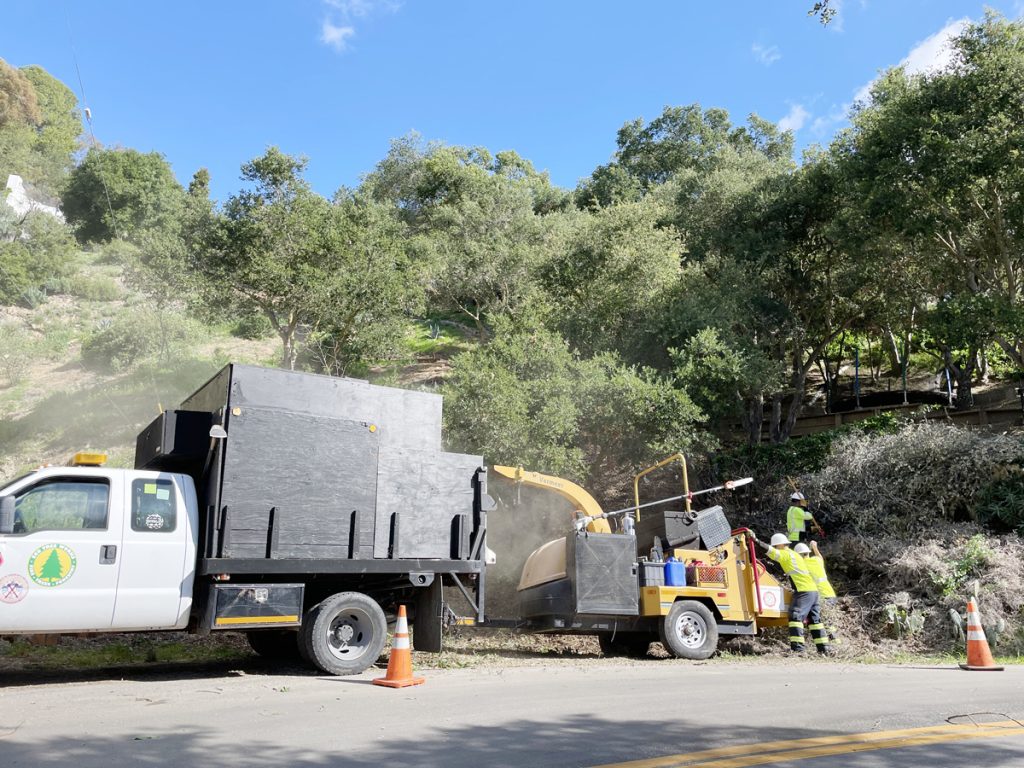
Montecito has been evacuated 10 times since the Tea Fire due to life threatening wildfire and debris flow events. According to Chief Taylor, these events provided the District with information that informed the existing Evacuation Plan, but the plan does not consider spatial analytical methods like spatial statistics, critical cluster optimization, and traffic simulations.
The study included four key components: critical review of 18 evacuation after-action reports across California; a community survey with 118 Montecito resident responses; interviews with police and fire subject matter experts; and traffic operations modeling to identify locations where congestion accumulates on our roadway network.
Information gleaned from the after-action reports indicated that communication, messaging, and information sharing was inconsistent; destination shelters were unprepared and hotels lacked capacity for evacuees; and re-entry into evacuated areas was inefficient and with inconsistent messaging. According to Richer, survey responses from residents in Montecito showed the most significant evacuation concerns include the ability to return home, transportation, and road conditions limiting evacuations, and knowing the destination of where they are evacuating to. Respondents showed a high evacuation knowledge and willingness to evacuate, as well as a high confidence in sheltering in place if told to.
Five fire agency and law enforcement representatives were interviewed for the study, including four fire chiefs and one sheriff’s deputy. The purpose of the interview was to better understand mass evacuation from an Incident Command/boots-on-the-ground perspective from various jurisdictions, in order to prepare a more comprehensive evacuation analysis for the MFPD. Interviews included questions that addressed advanced planning efforts, public information and noticing, and post-evacuation and recovery.
Traffic operations modeling considered two separate wildfire scenarios developed by staff using fire modeling software validated by recent experiences with wildfires on the front country of Santa Barbara County. Both scenarios included an afternoon evacuation order for three zones above Highway 192 with a corresponding evacuation warning for the three zones adjacent to the order zones. This level of order/warning is considered standard for a wind-driven wildfire in our jurisdiction, according to Chief Taylor, who later told us it would be unlikely that the entire community would be ordered to evacuate at the same time during a wildfire incident. The modeling established evacuation flows that are realistic and take into account school traffic; the modeling works similarly to traffic apps that reroute cars when there is congestion. It concluded that there would be a spike in evacuation trips on top of heavy commuter traffic in Montecito during the first 30 minutes of evacuation, and congestion on local streets, back roads to Santa Barbara, Highway 101, and on freeway on-ramps. The modeling did not take into account three years of upcoming construction on two roundabouts and the freeway, which Board members voiced concern about.
The study offers the District several recommendations, divided into the categories of wildfire mitigation (strategies to help prevent wildfires, which the District is already employing), demand-side (strategies that influence when, how, and where community members evacuate), supply-side (strategies that influence the physical and operational roadway infrastructure that facilitate an emergency evacuation), education/outreach, and capacity building/coordination.
“I’m so beyond pleased with the results of this report,” Chief Taylor said. “It validated what we anecdotally believed to be true. The study provides us a scientific analysis of existing conditions, now it’s up to us to look at it from an operational perspective, to reduce the stress on existing infrastructure.”
Chief Taylor said that District staff will now utilize the study, which was formally approved by the Board of Directors, as a starting point on which to formally evaluate procedures related to evacuations. “Evacuation orders will be precise and based upon the current conditions, our messaging will be clear, concise, and consistent, and we will work with the Sheriff and California Highway Patrol even more as it relates to traffic control points,” he said, adding that the addition of a full-time Public Information Officer has been a positive move for community outreach.
MFPD continues to build resilience, in small and large ways that collectively strengthen and prepare the community. One of the ways the District prepares for wildfire is through its Neighborhood Chipping Program, which takes place from February to June. 2022 marked the 13th year of the program, which asks residents to cut down overgrown vegetation within 100 feet of their home and stack it in piles on the curb. Then, a chipping contractor chips the vegetation on-site and hauls it away to a local recycling facility. This year, MFPD offered the program to approximately 1,500 residences in 10 neighborhoods within the fire district boundary. These areas are identified as part of the Very High Fire Severity Zone and therefore, are prioritized for brush clearance. A total of 225 properties participated in the Chipping Program this year.
Montecito Fire’s Wildland Specialists Maeve Juarez and Nic Elmquist coordinate the program, as well as conduct Defensible Space Surveys. After walking a property, Wildland Specialists provide homeowners with a Defensible Space Survey report that documents any needed follow-up work to achieve 100 feet of proper defensible space around the home, as required by law. They also suggest small changes that can be made to the home itself to limit the potential damage from wildfire, known as home hardening.
For Fire Prevention Month in October, firefighters visited local schools to educate children about fire safety, and released messaging to the community that the fall is the time to be “Set” with wildfire evacuation plans and consider what actions would be taken if a wildfire occurred in Montecito.
Copies of the “Ready, Set, Go!” wildfire action plan are available at both Montecito Fire stations as well as online at montecitofire.com.
In December, MFPD gave us the scoop on new wildfire cameras that will help spot fires in the front country, including in Montecito.
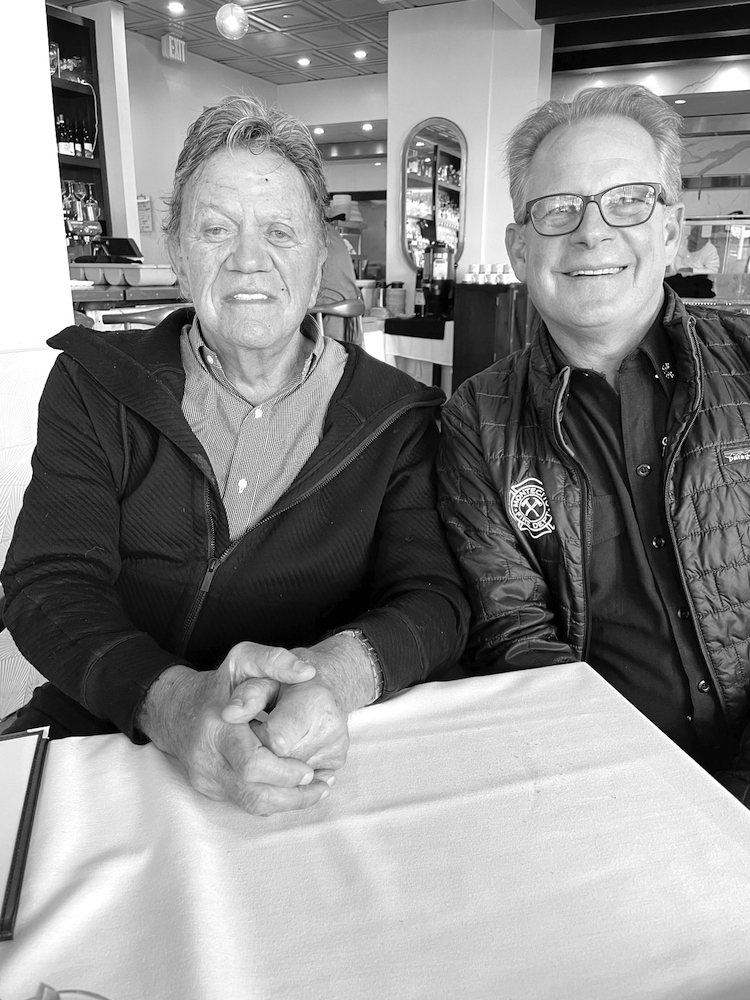
When Wildland Fire Specialists from Santa Barbara City Fire Department and Montecito Fire Department started talking about where to place a camera that would detect smoke and flames in the initial moments of a wildfire, there was a clear answer: Santa Barbara’s TV Hill is now home to an ALERTCalifornia camera. This camera will provide 24/7 “eyes” on the Santa Barbara Front Country and eventually, alert firefighters to new fire starts using artificial intelligence technology.
The network of ALERTCalifornia cameras is rapidly expanding across the West. The camera on TV Hill and plans for another on Ortega Ridge will join a network of hundreds of cameras that provide coverage of wildland areas. Currently, there are two cameras on Gibraltar Peak.
“Thanks to these cameras, it’s now rare that we respond to a fire that we don’t have eyes on before going to it,” Montecito Wildland Fire Specialist Nic Elmquistsaid. “But until now, we have had limited coverage of the South Coast’s wildland areas. It’s a huge advantage to be able to watch an incident emerge from the first puff of smoke.” Elmquist said within the first few minutes of a wildfire, the cameras’ AI technology can detect smoke and send an alert to firefighters. That alert includes a weather report from the nearest weather station, a precise location of the fire, map of the area, as well as a computer-modeled, three-hour prediction of the fire’s potential spread.
The camera views are also publicly available so that community members can gain a better understanding of where a fire is burning. The conversation around implementing more wildfire detection cameras on the South Coast has been ongoing for years, spearheaded by Montecito resident Wayne Siemens. Siemens came to Montecito Fire Chief Kevin Taylor in 2021 with the idea for the cameras. Chief Taylor brought the suggestion to the Montecito Fire Board of Directors, who allocated funding this year for the program. Montecito Fire’s Prevention Bureau staff then brought the idea to fruition.
Twenty thousand dollars have been allocated from the Fire District’s general fund for the cameras. Chief Taylor says it is a worthwhile, long-term investment in fire safety and prevention. Chief Taylor hopes the TV Hill camera and Ortega Ridge camera, planned for installation in early 2023, will be the start of many more cameras to come across the South Coast.
Montecito Water & Sanitary Districts
Our local water and sanitary districts kept busy in 2022, keeping an eye on the drought, infrastructure, and conservation.
In January, as part of its Capital Improvements Program, Montecito Water District began upgrading approximately one mile of water main on East Valley Road. The work was completed over the summer.
Montecito Water District is now 100 years old, which means 20 miles or so is also 100 years old and needs replacement. General Manager Nick Turner said the District will complete at least one major pipeline replacement per year, as there are also many miles of 80- or 90-year-old pipelines that also need replacement. These projects improve water delivery reliability by helping prevent water outages and water loss experienced during main breaks.

In May, Turner was in front of the Montecito Association Board of Directors, presenting an overview of drought conditions and a summary of the District’s 5-year Strategic Plan, which was adopted earlier this year. The agency is currently governed by a board of five, including President Tobe Plough, Vice President Ken Coates, and directors Brian Goebel, Cori Hayman, and Floyd Wicks.
Turner explained that there have been significant periods of drought over the last century, which have led to the addition of water supply sources, including in 1929-35 when Jameson Lake was added as a water source, 1949-51 which led to the acquisition of the Cachuma Project as a new water source, 1987-92 when the State Water Project was added, and 2010-now, which has led to a number of various efforts. Those efforts include the 2015 Urban Water Management Plan, the acquisition of groundwater storage rights in 2017, a feasibility study for water reuse in 2018, and perhaps most significantly, the execution of a 50-year Water Supply Agreement with the City of Santa Barbara for desalinated water in 2020.
Because of thoughtful planning and foresight, the District’s water sources have become increasingly diverse and include: Jameson Lake, Doulton Tunnel, Cachuma, State Water Project, supplemental purchases, groundwater, and desalinated water. Now, with water sources diversified, the District is contending with increased demand, despite asking customers for voluntary reduction last summer. From July 2021 to January 2022, customers complied and achieved a significant reduction in water usage. But February and March of this year saw a stark increase in water demand, and Turner said consistent conservation is what is needed.
According to the Strategic Plan, the challenges the District face are projected water supply shortages, aging infrastructure and facilities, an aging workforce, the need for employee development, water policy impacts, managing water supplies efficiently, and implementing water reuse. Future goals including bolstering water supply reliability through additional diversification, enhancing infrastructure dependability through replacement and rehabilitation, improving operations through planning and investment for qualified personnel, and advocating for the community for water policy inclusion.
The Montecito Water District’s Strategic Plan is available on MWD’s website at montecitowater.com.
The District continued to study the feasibility of recycled water this past year, with a study completed over the summer. The study was in conjunction with Montecito Sanitary District (MSD), building on the 2018 Recycled Water Feasibility Study, and focused on direct potable reuse and indirect potable reuse options with particular emphasis on regional partnerships with neighboring agencies. Both MWD and MSD are also studying whether consolidation between the two districts is deemed feasible, appropriate, and desirable for the community. A merging of the two special districts could improve the short- and long-term effective management of water resources, and avoid future misalignments of the two agencies on recycled water and other joint interests, according to the Strategic Plan.
In June, MWD Board of Directors adopted an updated drought ordinance after regulations were put forth by the State of California. This new drought ordinance (Ordinance 97) replaces Ordinance 96, which includes the District’s current water conservation requirements.
Ordinance 96 conservation requirements are still in effect, and include the prohibition of washing of hard surfaces such as driveways, sidewalks, patios, and parking lots. Irrigating landscaping during and within two days of measurable rainfall, and irrigating landscaping in a manner that causes water to flow onto an adjacent property, walkway, street, parking lot, etc. is prohibited. Irrigating landscaping is only permitted between 6 pm and 10 am (evening, night, morning) to reduce evaporative losses, and water leaks must be repaired immediately. The entirety of Ordinance 96 is available online at montecitowater.com.
Ordinance 97, the District’s new drought ordinance, does not change those prior water conservation requirements, and those will continue. Instead, Ordinance 97 (a) elevates the District’s declared water shortage condition from Stage 1 to Stage 2 and (b) adds all water conservation measures (total of five new) that are listed under a Stage 2 water shortage condition in the District’s Urban Water Management Plan. These actions are mandated by the State Water Board regardless of the District’s actual water supply condition, said Turner. “The intent of this action is to force conservation in hopes of achieving between 10-20% reduction in statewide water use,” he said.
The District’s five new conservation measures are as follows: targeted conservation communication to highest water users; increased water waste patrols; pool, spa, and pond refills are prohibited (“top-offs” are okay); pool and spa covers are required; and outdoor irrigation is limited to every other day of the week. According to Turner, no specific days are designated for the limited irrigation requirement, and customers may select the days that work best for them. Irrigation may take place every day on a property provided the irrigation of a particular landscape is no more frequent than every other day.
The District continues to place significant focus on the importance of water conservation in addition to their favorable water supply outlook. Turner says that it is imperative that District customers use water efficiently. With 80-85% of the water use in Montecito occurring outdoors, the most effective way to achieve an immediate reduction in water use is to reduce either the amount of time and/or the frequency that the irrigation occurs on a property. The District also encourages all customers to confirm they do not have a leak occurring on their property by looking for the leak indicator symbol on their water meter and inspecting the entire property, and invites customers to schedule a water conservation audit with the District. The District’s website also includes helpful tips on how to reduce water use.
In August, MWD further bolstered this message of water conservation by installing a road sign at the triangle on Olive Mill Road and Hot Springs with the rotating message: “Extreme Drought, Reduce Irrigation.” The goal is to get customers’ attention so that they will reduce water use now. The quickest, most effective way to do that is by cutting back on irrigation. With customer use trending more than 20% over budget for the second year in a row, the District needed to turn up the volume on its call to action: get water use back on budget.
According to District data, increased usage is widespread across more than 70% of single-family residences, which is the District’s largest customer class and greatest water consumer.
In a Special Board Meeting held in September, Directors again discussed how to get customers to reduce water use voluntarily and avoid the need for stricter measures such as financial penalties. A year ago, the District established a 20% water use reduction goal to promote conservation. As with the Governor’s request for 15% less water use, response has fallen short. In spite of extensive customer messaging over the past year, the District has seen only a minor improvement in water conservation since 2021 and water use continues to trend approximately 25% over budget.
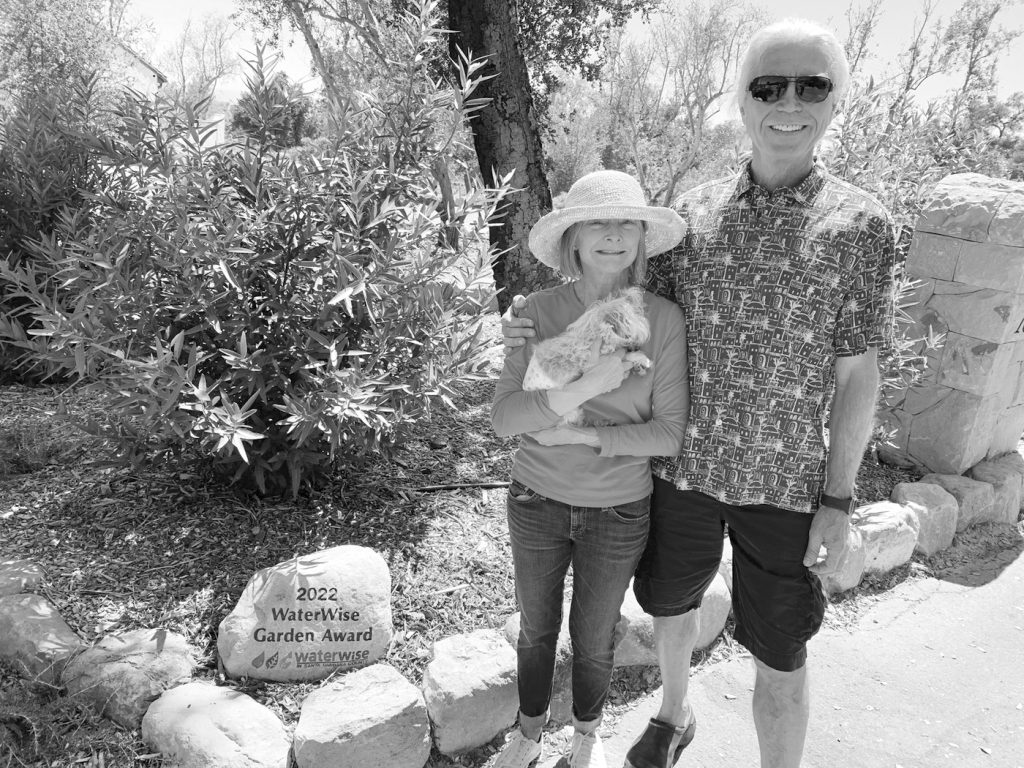
On the District’s website, montecitowa
ter.com, customers can find a variety of resources to help with water conservation, and the District provides free on-site visits tailored to the needs of each property.
Also in September, Montecito residents John and Teri Keating won the 2022 WaterWise Garden Recognition Contest launched this spring to recognize beautiful, water-efficient residential gardens throughout Santa Barbara County. The Santa Barbara County Water Agency and participating local water providers encouraged residents to apply for the contest and enter into the running for an agency award and the countywide grand prize. A winner from each participating water provider’s service area received an engraved sandstone sign to display in their gardens. This year’s participating water providers were the Montecito Water District, Carpinteria Valley Water District, Vandenberg Village Community Services District, and the cities of Solvang and Santa Barbara.
On January 9, 2018, the Keatings’ property exploded into flames when the debris flow rushing down San Ysidro Creek ruptured a 22-inch, 1,000-PSI main transmission gas line that ignited the pilot light in their garage. It has taken over four years since the explosion to rebuild their home and redo the landscaping. The Keatings wanted to recreate a similar ambiance to their original water-wise landscaping while accommodating the new 80,000-pound boulder that landed on their property from the explosion. They also wanted to plant California natives, specifically California Bay trees, as their perimeter hedging in memory of their 40-foot-tall California Bay tree that was stripped away during the debris flow.
In Passing
The Journal has long been a place to submit stories and obituaries of friends and loved ones who have passed, usually with a connection to Montecito. These are a few of the individuals we lost in 2022.
January marked the passings of Martha Maxwell (Maxi) Dickinson Heimlich Riggs Bohannon Decker, DeAnna Joy Wassom, John W. McIntyre, and Louise Larson Darlington Levine. In February, 22-year-old Justin Bruce Forrester passed away in Santa Barbara, Derek (Derk) Kenneth Hunter passed away peacefully, and director Ivan Reitman died at the age of 75 at his Montecito home. Kirsten Marie Donnelly also passed in February. In March we published the obituary of Helene Zalk Pollock.



In April, Montecito’s beloved retailer and vintner Pierre Lafond passed away at the age of 92. Pierre Lafond and his wife, Wendy Foster, developed a number of shops in Montecito and in greater Santa Barbara.
In June, we noted the passing of longtime Montecito resident William Jones, and in July, John Joseph Macker, a longtime Montecito resident, passed away at the age of 78. August marked the passing of Richard Ray Easbey and Lawrence (Larry) Wayne Kelly, and in September, we lost two centenarians: Evelyn Louise Duimovich, age 100, and Natalie Salter Myerson (Mrs. Raymond King Myerson), age 102.
James Custis “Denny” Crimmins, Nelson Huber, Gerald Wayne (Jerry) Fronterhouse, Barry Allan Kitnick, and Jacqueline Hiske Rubinstein also passed away in September.
In October we published a tribute to Lady Leslie Ridley-Tree, who passed away at the age of 98. A great number of local charities and nonprofits could always depend upon her to fill a table for an event; her legacy of giving includes Sansum Clinic, the Ridley-Tree Cancer Center, Cottage Hospital, the Ridley-Tree Education Center Art Camp, Westmont College’s Ridley-Tree Museum of Art and the 33 Ridley-Tree Nursing Program scholarships there, UCSB’s 40 KITP Graduate Science area scholarships for young people with disabilities, and SBCC’s 30 Single-Parents-Returning to Education scholarships. Other institutions at the receiving end of her generosity include the Santa Barbara Zoo, Santa Barbara Museum of Art, and many others.
October also marked the passing of Otto W. Laula and Scott Starr. Margaret Anne Baker passed away in November.
If you would like to publish an obituary or tribute, please contact us.
Thank You!
As always, we’d like to extend a big THANK YOU to our supporters, advertisers, contributors, our production team, and most importantly, our readers, without whom we would not be able to put this publication together week after week, for over two decades.
We’ll see you in 2023!





